Table of contents

How to Train for Hiking & Backpacking Trips
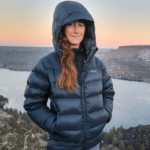
Some of the links on this page are affiliate links

If you’ve got your sights set on a difficult hike or an epic backpacking trip, it’s smart to prepare your body in the weeks and months leading up to it by doing some training. When you’re in tip-top shape, you can truly enjoy the experience instead of worrying about being sore and exhausted. Training can also be a lot of fun and you can do it at home without spending a dime.
If you’re already active and feel like you’re in good shape, you may think you don’t need to condition for your trip. But be honest with yourself – when’s the last time you put on a backpack and slogged up flights of stairs for hours upon hours? Hiking and backpacking are more than just walking, they’re an endurance sports. The more you train, the better you’ll feel when the big day comes.
The Benefits of Training

A BETTER EXPERIENCE
Training will allow you to enjoy your time on the trail more. Instead of feeling tired and miserable while hiking, you can focus on having fun and soaking in nature’s beauty. If you aren’t over-exerting yourself, you’ll have more energy left in the tank to explore side trails, take photos, savor your time in camp, or whatever brings you joy. If you have quads of steel, you’ll also be able to carry more food or luxury items, like a Kindle , mini travel game , or a flask . The benefits don’t end when the trek is over either. A fit person doesn’t need as much time to recover after a trip and their memories of the experience will be more positive.
AVOID BLISTERS & INJURIES
A little pre-trip training will help you avoid potential blisters and injuries. Developing strength and flexibility in the knees, ankles, and feet is especially critical for backpacking. Resistance training strengthens muscles and tendons while increasing the flexibility of the ligaments. This helps mitigate the risk of strains or tears. Training can also help prevent blisters by gradually toughening up the skin and by giving you time to break-in and become familiar with your footwear . Become a blister-fighting ninja by reading our How to Prevent and Treat Blisters While Hiking post .

MOTIVATION FOR LONG-TERM HEALTH & FITNESS
An upcoming adventure makes a great goal to motivate you to work on your fitness. Every time you think of those beautiful mountains you’re going to climb, your drive to walk or do squats will be reignited. It’s also a ton of fun to train since it gets you active and going outside regularly. You may even inspire your family or friends to train with you!
Conditioning doesn’t have to build up and end with a single trip either. You can use training to develop a bomber stress-relieving routine for your long-term mental and physical health. To galvanize training into your lifestyle, pencil in several challenging hikes or backpacking trips on your calendar throughout the year. For us, there’s nothing as powerful as an epic vista to incentivize ongoing exercise. Check out our Backpacking Trip Guides for inspiration.
Where to Start
Zero in on your goals.
Training is most effective when you have specific goals you want to reach, which is why it pays to do your research and get to know the route you plan to hike. Look closely at your backpacking itinerary and zero-in on logistics. Pay attention to details like how many miles you’d like to travel per day, how much elevation gain and loss there is on your route, and how much weight you’ll likely carry in your backpack . Remember to factor in food weight if you’ll have long carries between resupply points and water weight if you’ll traverse significant dry stretches. Once you have a good grasp on these facts, you can start practicing for these specific conditions. Check out our video on trip planning for more details.

NAVIGATE THE NUMBERS
It’s really helpful to know about how long it takes you to hike a mile for both training and trip-planning purposes. Your speed will change depending on your fitness level, obstacles on the trail, weather, and the weight on your back. Once you’re in shape, a good hiking pace to strive for (with a backpack on and over variable terrain), is 2-3 miles per hour. That’s about 20-30 minutes per mile. Plan to take about 30 minutes longer for every 1,000 feet of elevation gain (uphill).
The most important thing you can do to start training for a hike is to start moving regularly. It doesn’t really matter what you do, just get up and get your blood flowing for at least 20 minutes a day. Walk, dance, vigorously clean – whatever is the most accessible and enjoyable to you at the time. This will start exercising your heart and lungs – the real workhorses of hiking and backpacking. It’s best to start training about eight weeks before a big hike, but it can’t hurt to start earlier. If you’ve been sedentary for a while or your sights are set on a particularly long or challenging trip, we recommend training for at least a few months so you can ease into it gradually.

START A WALKING ROUTINE
Start walking as often as possible. Begin with a couple of easy walks per week. Then work up to doing several more intense walks mid-week and a longer hike on the weekend. Keep track of how many miles you walk, how long it takes, and how you feel. Some people like to use a phone app or a fitness watch, such as a Fitbit , to track their activity. These indicators will give you an idea of what your current fitness level is and how much you need to push yourself to be ready for your trip. Increase the length and difficulty of your walks in baby steps. The last thing you want to do while training is strain something and have to put your plans on hold. Consistently work towards small, attainable goals and make sure you’re enjoying yourself along the way.
HEAD FOR THE HILLS
Hilly terrain creates an excellent opportunity for bursts of intensity followed by periods of recovery, which builds up your endurance for backpacking like nothing else can. Alternating between high-intensity uphill sections and lower-intensity flat or downhill sections keeps your heart rate fluctuating. This type of interval training gives you a great workout in less time. It also revs up your calorie-burning ability and keeps training more interesting. Most importantly, it boosts your aerobic capacity, so you can eventually hike longer and steeper routes.

Once you’re feeling strong on your walks, start wearing a daypack to add to the challenge. Load your daypack with enough weight to account for about 25% of the total amount you plan to carry on your trek. Water bottles are heavy when full and make great weights. Gradually add more weight to the backpack until you can easily handle at least 75% of the total weight you intend to carry on your trip. Towards the end, you should transition to wearing the backpack you plan to use on your backpacking trip.That way you can practice making adjustments and troubleshoot any issues with friction or fit. If you’re not sure how heavy your backpack will be yet, check out our Ultralight Backpacking Basics Guide and our Ultimate Backpacking Checklist to learn more.

Finding the Time to Train With a Busy Schedule
We understand that it can be tough to find the time to train when you have a busy schedule. If all you can manage is a walking routine, don’t beat yourself up. Logging miles is by far the most important part of training. Bonus points if you can also carve out 20 or 30 minutes two or three times a week to do some of the following exercises. Your body will thank you for it. To maximize your time, focus on exercises that improve overall fitness and target multiple muscle groups with each repetition.
Strengthening exercises

PARTS OF THE BODY WE USE MOST WHILE HIKING & BACKPACKING:
- Core (abdominals, obliques, back)
- Legs (quadriceps, hamstrings, glutes, calves)
- Hips (hip flexors)

Top 5 Training Exercises
It’s ideal to do the following strength training exercises two or three times per week on the days you aren’t walking or doing cardio. Make sure to stretch and warm up for a few minutes before you start to protect your joints.

If you only have time for one exercise, do squats. They’re super effective at strengthening your glutes and legs, which are constantly challenged while backpacking. Stand with your feet shoulder-width apart. Keeping your knees in line with your ankles, bend at your knees and sit back as if you are sitting into a low chair behind you. Keep your chest open and upright. Then, driving your weight into your heels, stand back up, squeezing your glutes as you come up. Extra credit: Hold weight in hands while you do your squats to add resistance. Reps: 1-3 sets of 20+
Lunges will help strengthen your quads, the largest muscles in your legs so you’ll be ready to charge up those relentless uphill sections of trail. To do this exercise, start by standing with your feet together. Step your right foot forward and lunge forward. Then step your right foot back to meet your left again. Next, step your right foot to the right and lunge to the side. Bring your right foot back to meet your left. Then, step your right foot back behind you and lunge back. Bring your right foot forward to meet your left. Repeat on your left side. That’s one rep. Extra credit: Hold a weight or water bottle in each hand if you want to up your game. Reps : 1-3 sets of 10+

MOUNTAIN CLIMBERS
Mountain climbers give you a burst of cardio to help get your lungs and heart ready for backpacking. At the same time, they strengthen your core, which supports your load and provides stability on uneven terrain. Start in a high plank position with your hands directly under your shoulders on the floor and your legs extended behind you. Keep your body in a straight line and float your right knee up to meet your chest or outer right elbow (try both). Hold for a second, then, return your foot to plank position. Repeat with your left knee, using your core to keep everything tight. Repeat, as fast as you can with control, alternating sides. Reps: 1-3 sets of 20+
The step up exercise builds strength and endurance in your glutes and quad muscles, so you’ll be ready to step up and over any amount of downed logs or obstacles that stand in your way. You’ll need a stable surface, about 8 inches off the ground to step up onto. The bottom step on a flight of stairs works well. Start with your left foot on the ground and your right foot on top of the step (your right knee will be bent). Step up until you are standing with your right leg nearly straight and you’re balanced on top of the step. Pause in a balanced position with your left foot a few inches above the step. Then step down, returning your left leg and right foot to the starting position. Do all your reps on one side, then repeat the exercise on the other side. Extra credit: wear a backpack with some weight or increase the step height to add to the challenge. Reps: 1-3 sets of 20+

CALF RAISES/HEEL DIPS
Calf raises and heel dips will give you chiseled calves as well as strong ankles and feet, so you’ll be less fatigued and more stable on uneven terrain. You’ll need a stable step to do this exercise. The bottom step on a flight of stairs works well. Start with both feet on top of the step, positioned so that your weight is on your toes/balls of the feet and your heels are floating over the edge. First, stand up high on your toes, squeezing your calves and pausing at the top. Then, lower your heels, dipping them lower than the edge of the step. Come back to a neutral position, then repeat. Reps: 1-3 sets of 20+
Mental Aspects of Training

Hiking and backpacking can be intense both mentally and physically. Training will not only tone your body, but it will also help you develop mental stamina.
Your brain plays a critical role in training for a hike or big undertaking of any kind. The more you practice, the more confident you’ll become in your body and your abilities. After you reach a big goal for the first time, you’ll know what it feels like, and you’ll be certain you can do it again. You’ll likely find that you’re much tougher that you ever imagined and that you can breathe to get through challenges instead of giving up when things get hard.
If you’re having a bad day and you’re dragging, listen to music to get pumped up or push a little less if you need to. The toughest part is getting going. The hardest and most worthwhile hikes take perseverance, grit, and a positive attitude. Being present and having gratitude for the beauty around you will go a long way.

Shoes & Boots
It’s really important to wear the same footwear you’ll be wearing for your hike while you train. The more experience you have with your shoes or boots, the less likely you are to develop blisters or have problems on your trip. Wear your shoes for several weeks to get to know them and use the opportunity to nip troubles in the bud while resources are still close at hand.
We prefer to hike in trail running shoes most of the time because they’re lightweight, breathable, and they sap less energy with every step. Learn more about why we prefer trail running shoes for backpacking trips by reading or 5 Reasons to Ditch Your Boots article. We have experience with a ton of footwear and we’re happy to share it.
Check out our footwear lists for our top recommendations:
- Best Trail Running Shoes ( Men’s / Women’s )
- Best Hiking Shoes ( Men’s / Women’s )
- Best Hiking Boots ( Men’s / Women’s )
- Best Winter Boots ( Men’s / Women’s )

Training for High Altitude Hikes
It’s especially important to train before hiking and backpacking at high elevations. When we go higher than 8,000 feet (or 2,400 meters) above sea level, our bodies can start to be affected by the lower air pressure. Lower air pressure means there’s less oxygen for us to breathe and we run less efficiently because of it. It’s not uncommon to be more tired than usual, have a mild headache, or to feel like you need to breathe deeper to fill your lungs.

ALTITUDE SICKNESS
Altitude sickness, or acute mountain sickness (AMS) is a lot like a hangover. Some people are affected more than others and it can be a really miserable experience. Fortunately, there are precautions you can take to avoid it. That said, it’s important to know the signs and symptoms of AMS so you can keep it from escalating into a major issue (see HACE and HAPE below).
The first symptoms of altitude sickness are headache, loss of appetite, and trouble sleeping. If these symptoms don’t go away in a day or if they get worse you should consider descending to rest. More serious symptoms include vomiting, feeling dizzy, confusion or spaciness, feeling unable to walk, and having bluish lips or fingernails.
HACE & HAPE
High altitude cerebral oedema (HACE) or pulmonary oedema (HAPE) , are fatal conditions to look out for while hiking and backpacking at high altitude. Excess fluid in the lungs or fluid around the brain can kill you quickly. The good news is, these conditions rarely occur unless you spend a significant amount of time above 10,000 feet. Patients usually don’t present symptoms unless they spend more than 48 hours above 13,000 feet. Know the signs before you embark on an adventure in extremely high places. Shortness of breath at rest, confusion, or extreme drowsiness are signs of a life-threatening emergency.

TIPS FOR HIGH ALTITUDE SUCCESS
- Acclimate – If you’ll be traveling to a location with a much higher altitude than the place where you live, try to give yourself an extra day or two in town to get used to the lower air pressure before you start. If you plan to tackle a high mountain summit, build up to it by climbing lower mountains in the area in the weeks before if you can.
- Ascend gradually – Climb high during the day, but try not to camp more than 1,000 feet higher than you did the night before to give your body a chance to acclimate slowly (remember the phrase: climb high, sleep low).
- Adjust your pace – You may have to hike a bit slower than usual or take breaks more often. That’s okay. It’s critical to listen to your body and not push too hard.
- Drink plenty of water and eat well – Lots of water and a diet rich in carbohydrates will help stave off symptoms of altitude sickness. Snack often to fuel your body consistently.
- Avoid alcohol – Since hydration is so important at high altitude, it’s best to save the booze for celebration after your trip.
- Bring warm clothes – Temperatures fluctuate drastically during the course of a day at high elevations and conditions can change rapidly. Be prepared with a hat, gloves, and extra layers to regulate your temperature and keep you well-insulated, even in the summer.
- Wear sunscreen – The sun is extra intense at high elevations and the health of your skin plays a huge role in your ability to thermoregulate and stay well at high altitude.

Final Tips For Training
TRIP PLANNING
After you’ve had some time to train and you have an idea of what your body can handle, be honest with yourself about your fitness level and the amount of time you have left to make more progress before your trip. Revisit your trip plans and dial them in with realistic expectations. If you realize you’ve overestimated your abilities, you’ll still have time to adjust your plans. If you’re not going for a speed record, you’ll probably have a better time if you’re a bit conservative with your estimates. If you’re new to backpacking, check out our 12 Tips for Planning Great Backpacking Adventures Tutorial .

REST BEFORE THE BIG DAY – As your trip date approaches, plan to rest for a few days, or even a whole week before your trip. This will give your body a chance to fully recover so you can be at your best on the day of your trip. Light exercise is a good thing, just keep in mind that last-minute planning, packing, and travel can sap energy, so it’s best to take a break from rigorous training just before your big day. Eat well, sleep well, and get pumped!
Once you get into the habit of walking, moving, and getting outdoors, you probably won’t want to stop. We make continuous training for adventures part of our lifestyle. It helps relieve stress, gives us something to look forward to, and keeps us in shape so we’re not scrambling when the next opportunity for adventure comes up. We hope this helps you reach your goals and inspires you to plan a trip if you haven’t already.

Related Content
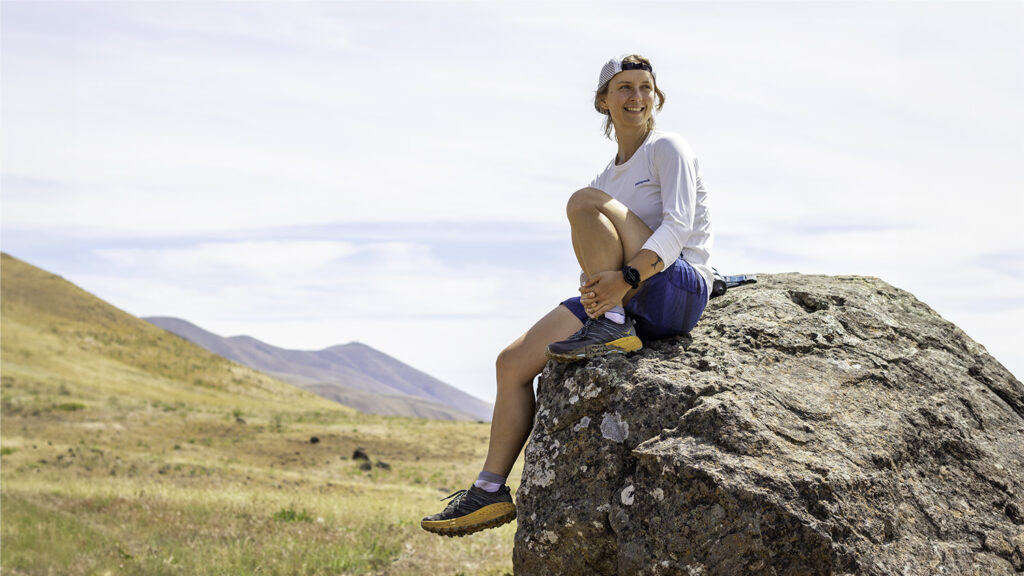
The 35 Best Ways to Save At REI’s Member Moment Event 2024
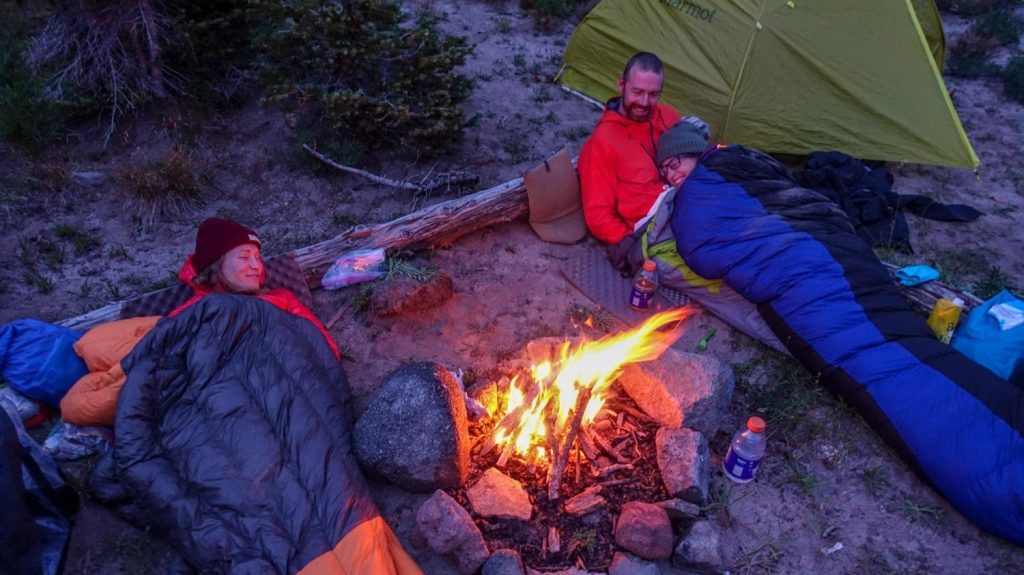
10 Campfire Safety Tips
Get the best content from cleverhiker & around the backpacking world.
Social media is great, but our bi-weekly newsletter is a much better way to stay in the know.
Sign up to get our curated emails with the best content from CleverHiker and around the backpacking world. You’ll be turned on to new videos, trip reports, gear reviews, inspiring outdoor stories and much more. So get in the mix!
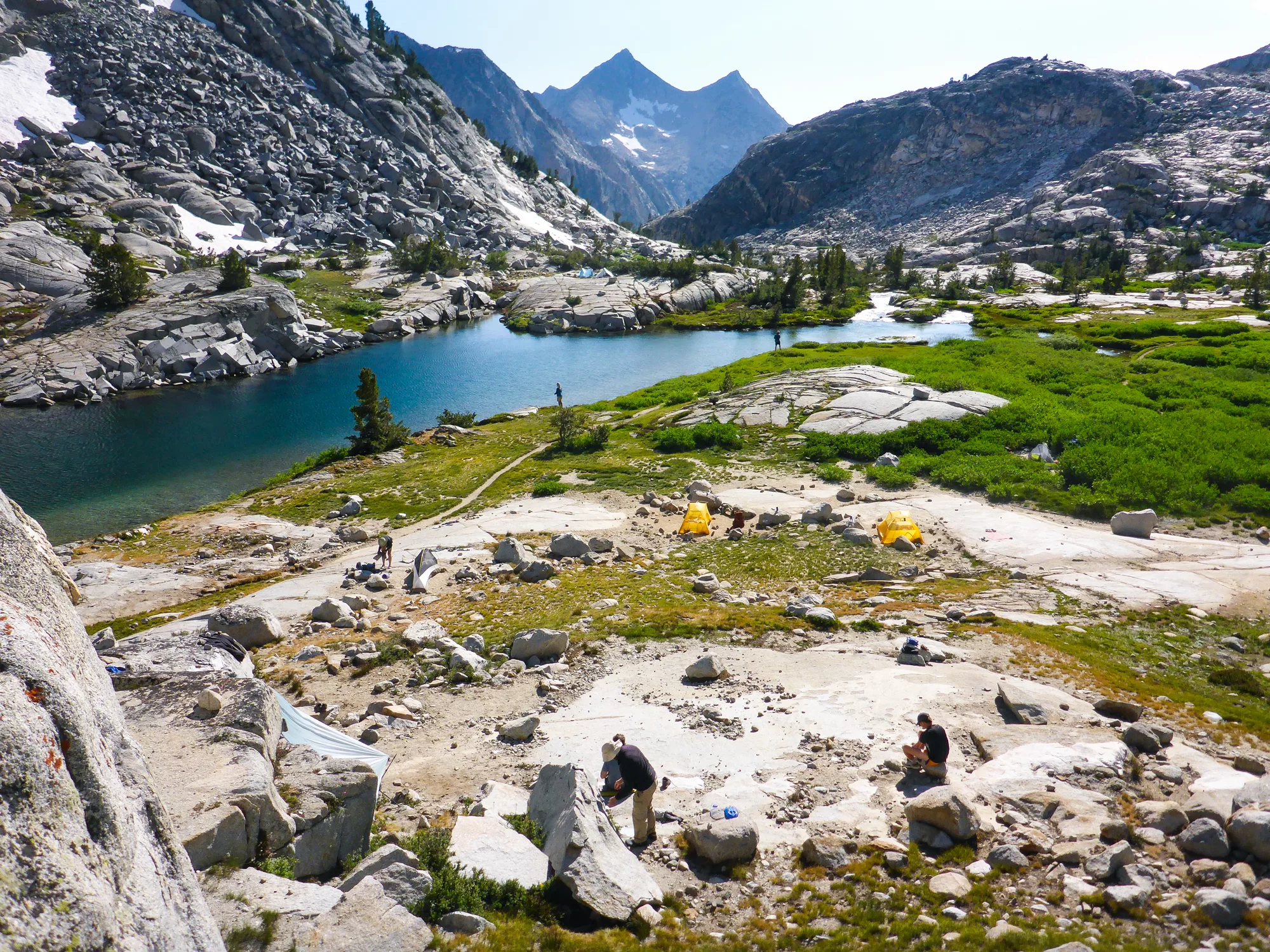
Guided Backpacking Trips
Backpacking in yosemite and the high sierra.
The Yosemite Wilderness and the Sierra Nevada contain some of the most beautiful mountain scenery in the world. With our carefully crafted itineraries, we’ll show you the best that these special places have to offer including the John Muir Trail and Mt. Whitney. Whether you’re new to the backpacking scene or a seasoned expeditioner, our trips take you away from the crowded highways so you can truly experience the freedom of the hills. All of our guided backpacking trips can also be scheduled as a private custom trip with your dates and itinerary.
Plan a custom backpacking trip with SYMG
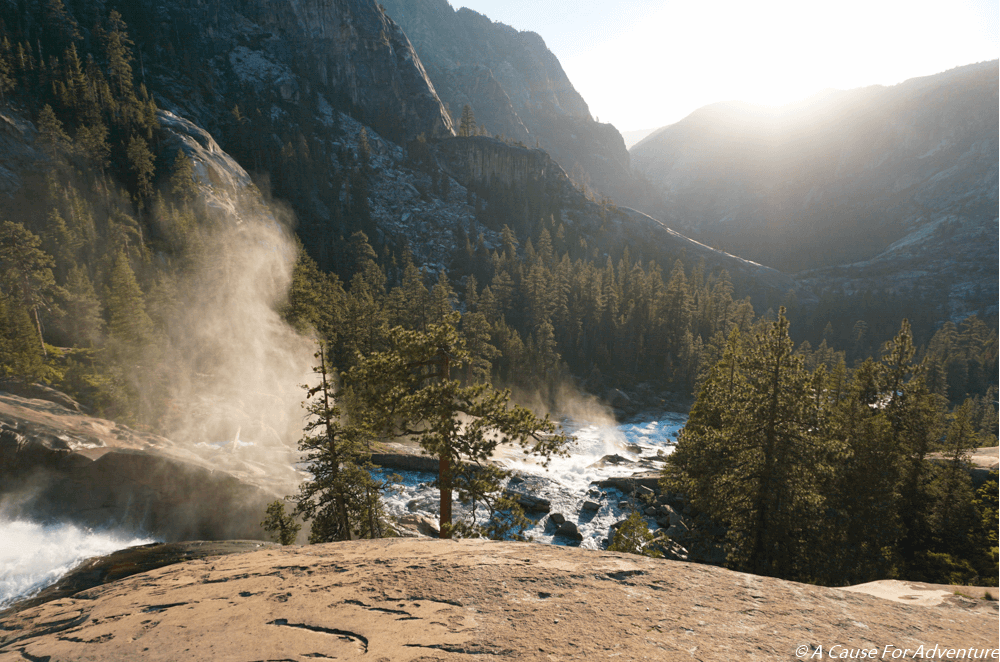
We couldn't find any trips matching these filters.
Try removing some options to find the perfect trip for you!
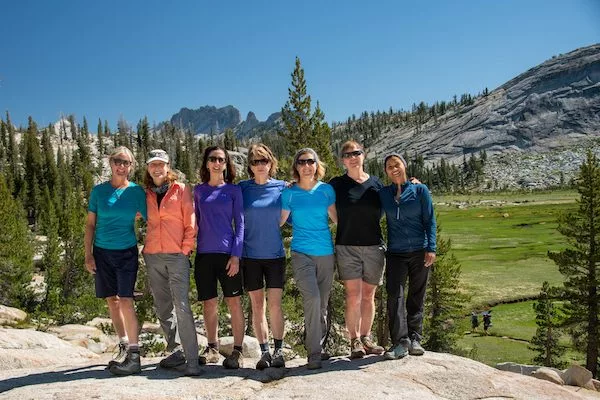
Custom & Private Trips
At SYMG, we specialize in planning and executing every type of outdoor experience. From expedition style John Muir Trail backpacking trips to family-oriented adventure camping, we tailor fit each detail to you!
Planning Your Guided Backpacking Trip
Backpacking questions.
The best training for hiking is… hiking! So, get outside and enjoy some local trails (preferably with elevation gain and loss). Also, think about striking a balance between cardio and strength training. Cycling, running, and swimming are fantastic. Gym workouts focusing on your leg muscles are great, as is training on stadium bleachers for those in flat areas. Daily stretching with Pilates or Yoga is also wonderful training when used in conjunction with the above. Our trips have a range of challenge levels, so you’ll want to develop a training plan that best suits the nature of your trip. Our office is happy to provide training tips and recommendations specific to your trip!
SYMG is happy to outfit you with the following high-quality gear free of charge at your request:
- Backpack (Deuter)
- Sleeping Bag (Mountain Hardwear, Marmot, Kelty, etc.)
- Sleeping Pad (Thermarest)
- Tent (Mountain Hardwear, Marmot, Kelty, etc.)
- Trekking Poles (Leki)
If you prefer to bring your own backpack, tent, sleeping bag and pad, you are welcome to for fit and familiarity. SYMG will also provide all group gear needed for multi-day departures including:
- Water Filters
- Group Shelter
- Emergency GPS device
- Group Bathroom Kit (trowel & toilet paper)
- Bear Cans (backpacking) or Bear Proof Panniers (Horsepacking)
- Camp Stools (Horsepacking only)
When you register for one of our trips, we will send you a full pre-trip package that includes a gear and clothing list specific to your trip.
During the summer months, average temperatures in the backcountry (7,000-10,000’) range between 65-75°F during the day and 30-40°F at night. Multi-day storm systems are rare, however, rain or snow showers can happen any afternoon in the summer, so it is important to bring proper rain gear. Each part of the season has different historical characteristics. Here’s a link to our favorite and most accurate high elevation forecast: NOAA Yosemite High Country Weather . For day trips in and around Yosemite Valley (4,000’), you can expect warmer temperatures (averaging mid 70s- high 80s°F and lows of 40-50°F) Yosemite Valley Weather .
We take pride in our efforts as a full-service outfitter. As our guest, you are only responsible for setting up and taking down your tent, packing your personal gear, and filtering your water. Of course, our guides are always available to assist. Other camp chores such as cooking, cleaning, hauling water, packing up/down of camp, etc are left to the guides, leaving you to relax and enjoy the backcountry.
On the trail, each group has its own dynamic and pace. Every group has folks who are faster, and folks who are slower. The guides excel at pacing the group appropriately, taking into account the ability of all participants. Typically, the group behaves sort of like an accordion. That is, there’s room to spread out and get into your own hiking groove. The guide, who is always in the lead (and another guide in the back on fuller trips), will periodically bring the group back together at trail intersections, lunchtime, tricky spots, or at points of interest.
The High Sierra lakes and streams we travel in are notable for the fishing opportunities! High Sierra Lakes hold fish in the 6-15′ range typically. Brook (mostly) and Rainbow Trout are commonly caught but its also possible to catch German Brown and Golden Trout depending on your location. We typically recommend the practice of catch and release. If keeping fish, we recommend keeping fish over 12′ and the Brooks only. You’ll be responsible for cleaning your own fish and will need to discuss with your guide a plan for cooking and eating them. Each person will also need a CA Dept of fish and game fishing license which you can pre-purchase online .
As far as fly fishing gear. We recommend bringing a 3-7 piece, 4-6 weight rod for the lakes and streams of the Sierra. Hard cases for pack trips mandatory. Recommended fly patterns are:
- Dry: Elk Hair Caddis, size 14, 16, 18. Adams, size 16, 18, 20. Royal Wulffs and Royal Coachmans, size 14, 16, 18. Stimulators, sz 10-12-14
- Nymphs: Hare’s Ear, size 14, 16. Pheasant Tail, size 16, 18, Wooley Buggers sz 8-12, Stone Flies sz. 8-12, Princes sz 10-12-14
- In Fall add terrestrials: Ants, hoppers, beetles
- 4x-6x tippets
If you use spinning rods , telescoping are best for packing. Small (1-2 lbs test is best). Lures should be barbless and single if possible, although treble hooks aren’t mandatory.
- Recommended lures are: Small Mepps, Rooster Tales, etc. Mepps Trouter Kit Plain: Little Wolf Silver, #1 Thunder Bug May Fly-Gold, #0 Agilia Long Silver, #1 Black Fury Fourescent, #1 XD Silver Body/Silver Blade, #1 Agilia Gold Undressed
Preparing for your backpacking trip
How to get in shape for a backpacking trip
How to pack for a backpacking trip
MORE BACKPACKING FAQ’S
More ways to experience yosemite & the high sierra.

Pack Supported Trekking Trips
Want to get out in the backcountry but don't want to carry a heavy backpack? Then our Yosemite and High Sierra Pack Trips are just the thing for you! We don't hike with the mules each day, but they do pack our gear and provisions along the trail, leaving you to enjoy the day and explore with your professional guide. Plush camps, amazing food, world-class scenery, and engaging guides make SYMG's Horsepack supported trips through the Yosemite High Country a trip to remember. In addition to the Pack Trips we offer, we can also organize private departures of any of our trips, or even create a custom trip just for you.

Rock Climbing
Since 1991 we've been offering Guided Yosemite Climbing in the southern Yosemite high country. All of our day trips are privately arranged and your personal guide will cater the days to your own personal interests and abilities. From easy top-roping for the family to challenging multi-pitch trad and sport routes, we can do it all. And if you're looking to expand your own skill set, consider our Rock Climbing Instruction courses: the rock climbing skills day and rock climbing camps.

Yosemite Hiking Tours
Since 1991 we've been offering Yosemite Hiking Adventures throughout the park. All of our day trips are privately arranged and your personal guide will cater the days to your own personal interests and abilities. Choose an interpretive day focusing on natural and cultural history walks to famous landmarks, or set out for a more challenging hiking day on one of Yosemite's long trails.

Guided Yosemite Camping Weekends
Join SYMG for Yosemite camping adventures focusing on hiking and rock climbing. Our professional guides cater the trips to your own personal interests and abilities, making these adventures a great choice for anyone. In addition the dates advertised, we can create custom trips for you based on your own preferences and timeframe. Great scenery, amazing food, well-provisioned camps, and fabulous guides make for an unforgettable experience.

Guided Patagonia Hiking Trips
Born from the travels of our renowned guiding staff, SYMG's International Adventure & Hiking Trips are have offered something distinctive for our travelers since 1991, while earning us the reputation as one of the "Best Outfitters on Earth".
Get the Newsletter
Follow for tips, trips and beautiful Yosemite images
You are using an outdated browser. Please upgrade your browser or activate Google Chrome Frame to improve your experience.

- Trip Styles
- Destinations
Yosemite Backpacking Trips

- Yosemite Hiking Tours Yosemite Backpacking Trips
Our guided backpacking tours take you into the heart of world-renowned wilderness destinations. Enjoy solitude and adventure as you embark on a self-sufficient journey deep into Yosemite!
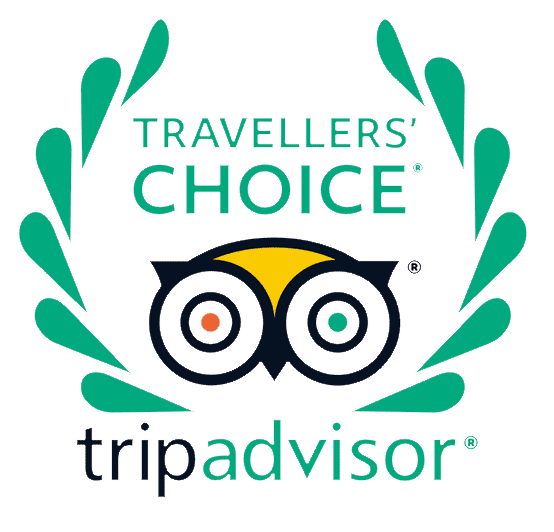
On our trips you’ll be able to focus on enjoying yourself while we take care of the details. Your guide will outfit you with gear, cook the meals, inform you about the landscapes you’re hiking through, and do everything they can to make your trip an unforgettable one.
Filter Trips
Trip length.
Yosemite Falls and North Dome Traverse
High Sierra Loop
John Muir Trail: Florence Lake to Yosemite
Half Dome Trek
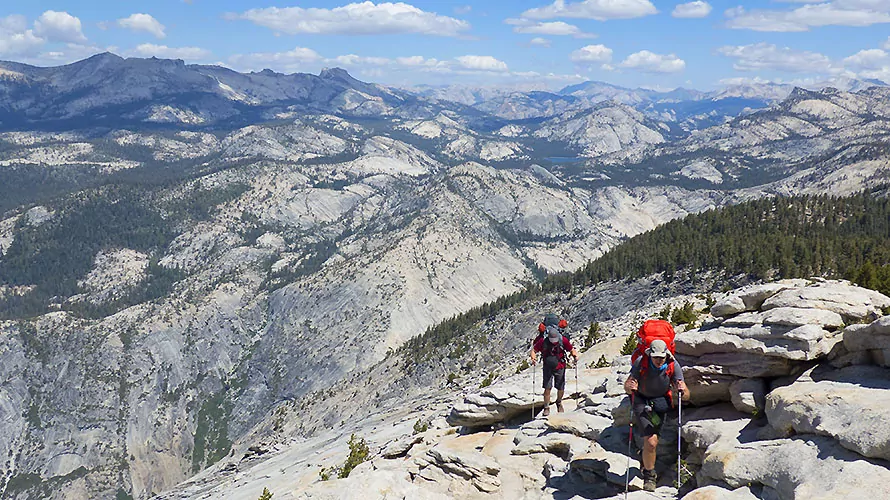
Yosemite Classic Summits: Half Dome and Clouds Rest
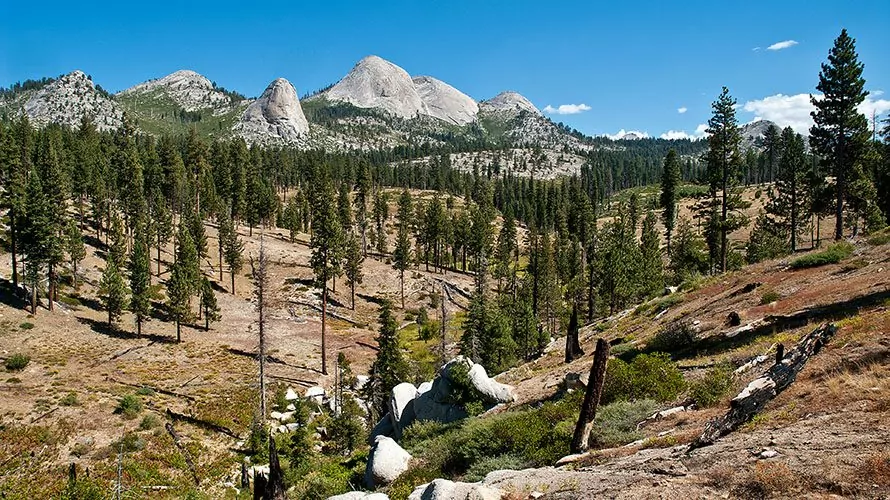
Wonders of Yosemite
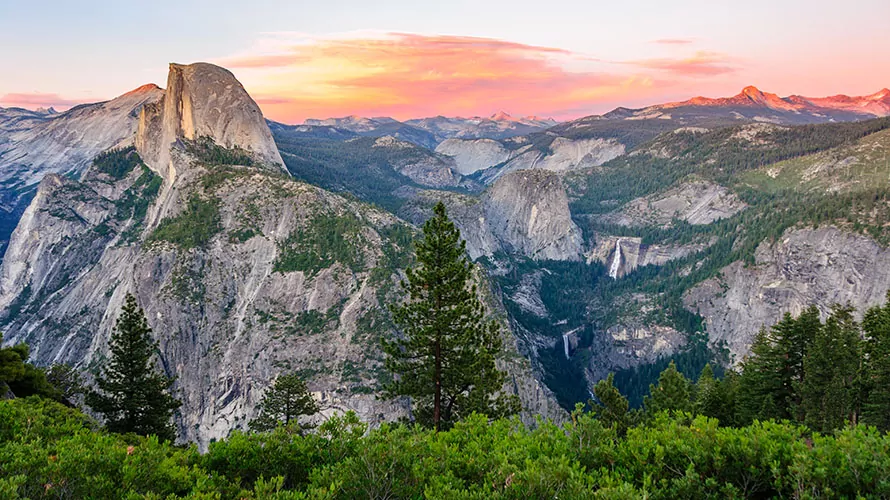
Glacier Point Trek
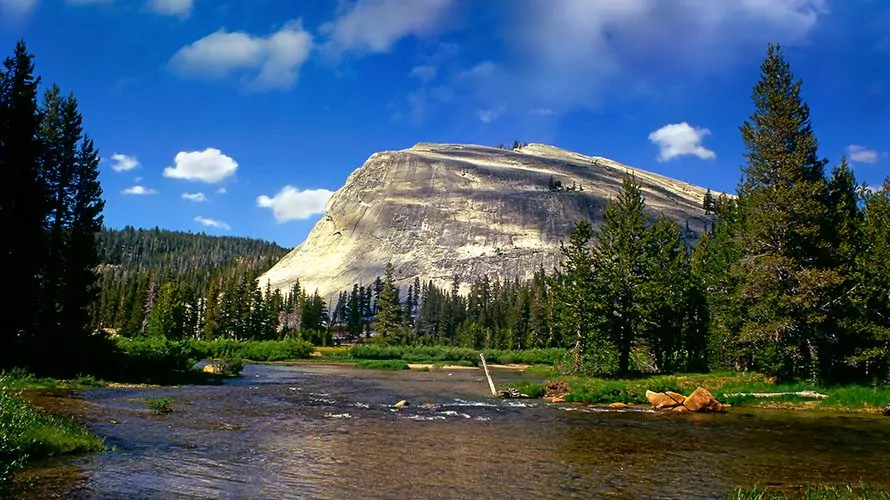
Yosemite Alpine Meadows and Waterfalls
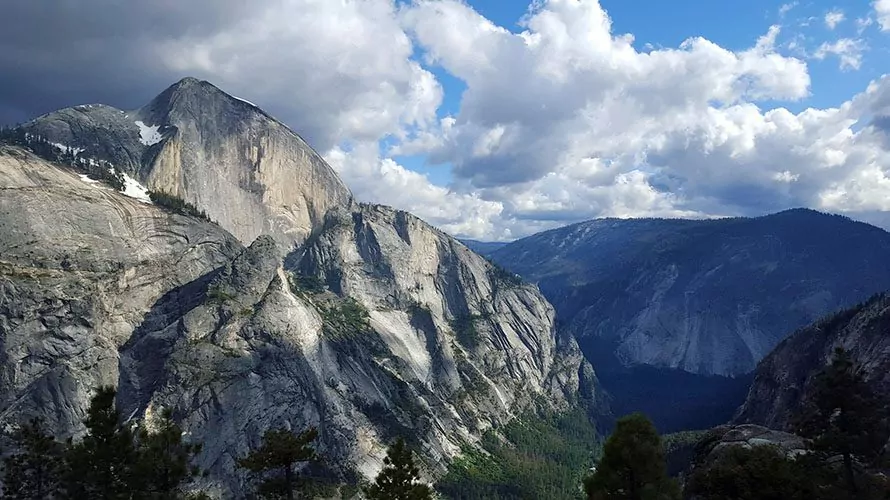
Women’s Yosemite North Rim
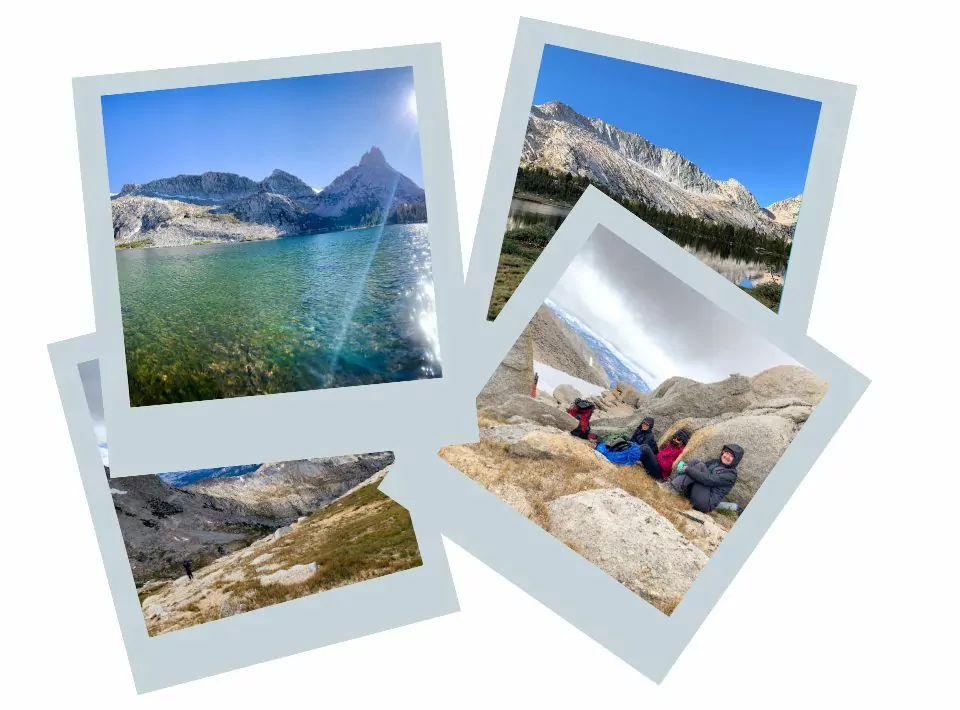
“Wildland Trekking is a wonderful organization that is committed to ensuring a positive experience for each individual. They are well organized, prompt and helpful for all the details that are needed for this type of an adventure. We would definitely use them again for future trips.” – Melanie Sullivan

Yosemite Basecamp Tours
Yosemite Camping Tours
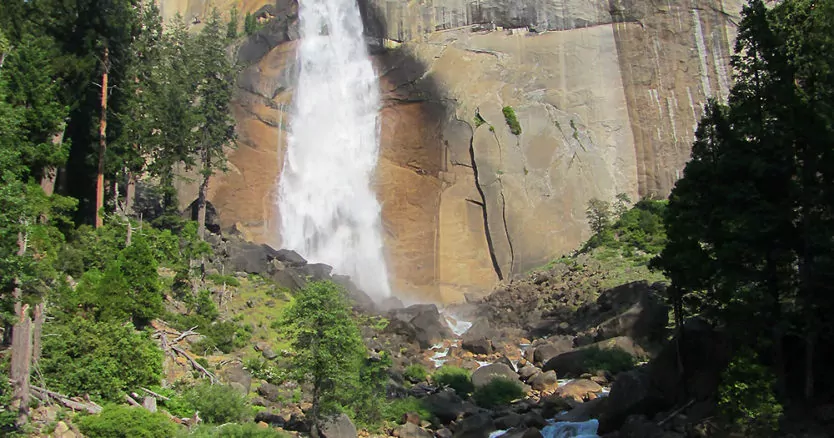
Yosemite Inn-based Tours
See Inn-based Tours
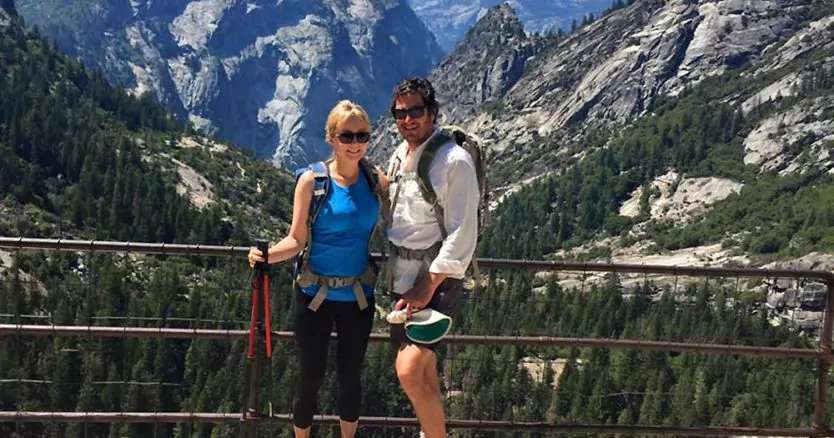
Yosemite Day Hike Tours
See Day Hike Tours
MORE ABOUT YOSEMITE BACKPACKING Trips
Why a guided backpacking trip.
Yosemite National Park is a vast wilderness with many, many backcountry hiking options. Every trip requires a backcountry permit, which is obtained 5.5 months in advance via a lottery system. Backpacking trips require significant amounts of gear, and backcountry experience is critical to make your adventure a fun and fulfilling one. Going with a backpacking guide company like Wildland Trekking gives you the opportunity to travel light, show up, have nearly everything taken care of for you, and then embark on a carefully selected itinerary that provides a world-class hiking experience of Yosemite led by an expert guide.
What’s Included
Our guided Yosemite backpacking trips include nearly all your gear, which includes backpack, tent, sleeping bag, sleeping pad, trekking poles, kitchen gear and more. We do ask guests to bring a couple small gear items like a headlamp and water bottles. Trips also include all meals from breakfast the first day through lunch the final day, transportation from the meeting point to the trailhead and back (this varies by trip due to Yosemite transportation logistics .) Of course every tour includes a professional Wildland Trekking wilderness guide to lead your trip, prepare meals, provide interp about Yosemite’s natural and cultural history and more. Finally, the finer details such as Yosemite backpacking permits are included so that our guests can focus on enjoying themselves and leave the tedious work to us.
CHOOSING THE RIGHT Yosemite TRIP
Yosemite has an overwhelming number of backpacking route options, and we offer a dozen trips at Wildland. So how do you pick the right one? Many guests want to do Half Dome because of its iconic nature, so that’s what they think of first. However, Half Dome is a unique experience that may or may not fit what you’re looking for. If being around quite a few people is ok with you, and summiting Half Dome is a top priority, then our Half Dome Backpacking Trip or our Classic Summits Trek will be great choices. If you’d like a longer trip with plenty of solitude and also want to do Half Dome, then our Cathedral Range Trek is perfect for you. If getting away from people and experiencing the silence and beauty of Yosemite’s wilderness is a priority, then a trip into Tuolumne Meadows, or down the Grand Canyon of the Tuoloumne, or Ten Lakes Basin, Wonders of Yosemite, or Mount Conness would be worth looking at. We’re here 7 days a week to help you as well at 800-715-HIKE (4453)!
WHY WILDLAND TREKKING?
Wildland Trekking began in 2005 as a backpacking company. Backpacking is still a major focus, but we also provide other trip styles including llama treks, basecamp tours, and inn-based tours. At our core, we’re a backcountry guiding company and always will be, and we’re expert at what we do. Our trips are all-inclusive; and our guides are carefully vetted, well-trained, and thoroughly supported with exceptional regional management and logistical teams. We’ve earned #1 spots on 6 national park Trip Advisor pages, and we hold solid 5-star review status at several more.
WHEN SHOULD I START PLANNING MY ADVENTURE?
We recommend beginning to play your trip approximately 4 months beforehand. Because of the limited number of backpacking permits awarded through the lottery system, and the high demand for guided backpacking trips in Yosemite, our trips tend to fill up quickly. Of course, there are often last-minute spots available, so if you didn’t make the 4-month mark don’t worry! There’s still a great chance of getting on a world-class Yosemite adventure.
How Do Yosemite Permits Work?
Yosemite backpacking permits become available 5.5 months in advance. We recommend registering for your trip before that time if possible, but waiting until the trip is confirmed to make your concrete travel arrangements like airfare and hotel rooms. We apply for the permits starting several days before the 5.5 month mark and know pretty quickly whether we were successful. When we’re successful, we immediately confirm the trip and guests are notified. If we are unsuccessful we continue applying each day so we can offer alternative dates. Certain iconic trips like the Half Dome Trek are much more competitive than lesser known trips like our Young Lakes and Mount Conness trip or the Wonders of Yosemite. We very strongly encourage guests who are booking Half Dome or Yosemite’s Classic Summits treks to think about backup itineraries like the two mentioned above. These more obscure trips can be equally or even more rewarding for many guests than the classics.
The Yosemite backpacking season is significantly longer than many mountain destinations because of the elevation differences between Yosemite Valley (home to iconic landmarks like Half Dome, El Capitan, Yosemite Falls and more) and the high country. Yosemite Valley is at about 4,500′ and the high country starts around 8,500′ and goes up to 13,000′.
Trips in Yosemite Valley – like our Yosemite Valley North Rim backpacking trip – can begin in late April or May. Half Dome and Grand Canyon of the Tuolumne open up in June, and our high country trips are fantastic from July through September. Then, again in the fall, the spring trips are great again while winter sets in in the high country.
How Fit Do I Need to Be to Backpack in Yosemite?
The level of fitness required to backpacking in Yosemite depends on the route or itinerary you’d like to do. For the most part, you can expect moderate to high levels of physical exertion. Yosemite is a mountainous national park, with a low elevation of 2,105 feet and a high elevation of 13,114 feet. That’s a very impressive 11,009 feet of vertical relief! You won’t have to hike that much uphill, you may have to gain some serious elevation. Add the weight of a multi-day backpack on your back (25-45 pounds), and you definitely need to be in good shape.
Backpacking trips range in difficulty from Level 3 to Level 5. We provide descriptions of the physical requirements for each level. Level 3 trips are a good place to start if you’re active and in good health. Level 4 and 5 trips are great to start with if you’re very fit and active, or to work up to by doing multiple tours.
Is Previous Backpacking Experience Required?
No. Our trips are designed for people who want to have a memorable backcountry experience in some of the world’s most amazing national parks and wilderness areas, whether they have backpacked before or not. It is important to be physically active and in good health, but the level of experience of our guests ranges from completely new to backpacking to very experienced and everything in between.
Logistical Considerations
- Gear : we provide almost everything. We do ask that you provide a headlamp and water bottles. Some guests choose to bring their own sleeping bags.
- Clothing : when you register, we provide you with a packing list that details the required clothing. An abbreviated list includes hiking shoes or boots , hiking socks, long underwear, trekking pants/shorts, fleece or wool layers, an insulated jacket, rain gear, warm hat and gloves, sun hat and more.
- Vehicle : most of our Yosemite backpacking guests have a vehicle and must leave it somewhere during the trip. These tours rendezvous at Curry Village, and you can leave your vehicle there.
- Luggage : the best places to leave your luggage while on the tour is either in your vehicle or at your pre-trip or post-trip hotel.
yosemite visitor information
Tips for visiting yosemite.
- VISITING YOSEMITE : Learn about Yosemite’s top highlights, best hikes, best tours, visiting in winter and a lot more!
- ULTIMATE GUIDE TO YOSEMITE NATIONAL PARK : This is a blog post written by Wildland staff to help visitors make the most of their visit to Yosemite.
- WHEN TO VISIT YOSEMITE : Get information on every month of the year and find out which one will work best for you.
- 10 MUST SEE YOSEMITE HIGHLIGHTS : There are 10 highlights you can’t miss in Yosemite – see them here.
- TOP YOSEMITE TOURS : Learn about the best tours to do, including hikes, backpacking trips, helicopter tours, climbing and more.
- BEST YOSEMITE HIKES : Check out our list of recommended hikes to do in Yosemite.
- TOP WINTER HIKES IN YOSEMITE : Winter is a spectacular but unique season – learn the best hikes to do in the snowy months.
- WHAT TO SEE IN YOSEMITE IN ONE DAY : Find out everything you need to know to make the most one day in this national park.
- HOW TO HIKE HALF DOME : Get professional advice on hiking to the top of California’s most famous summit – Half Dome!
- YOSEMITE BACKPACKING PERMITS : Learn about the backpacking permit process which allows backcountry camping.
wildland Wires
Sign up to receive our exclusive Wildland Wire emails and stay up to date with Wildland Trekking's promotions, discounts, contests, outdoor tips and tricks, trip reports and more!
The 6 Best Shorter Backpacking Trips on the Appalachian Trail
The 2,200-mile Appalachian Trail takes a lot of research and preparation to thru-hike. If you don't want to tackle it all at once, you can break it up into sections.
Share this:
- Click to share on Facebook (Opens in new window)
- Click to email a link to a friend (Opens in new window)

Have you been interested in hiking the Appalachian Trail but you don’t have the time or interest to hike the whole trail at once, or the finances for such a long journey?
Well, we have good news: You don’t need any of that. There are 2,200 beautiful miles of trail between Georgia and Maine that you can break up into shorter, more manageable backpacking trips. They can be tackled in sections themselves, one at a time, or in groups, depending on your endurance, time at hand, and finances available.
So, head out on these shorter sections and enjoy some of the highlights of this incredible trail. In this article, I’ll share a description of six of my favorite sections and an example itinerary to help you create your own ideal route. Several of these can be turned into loop hikes using other trails that branch off the Appalachian Trail.
Soon, you’ll see why these sections are trail highlights.
The Best Shorter Hiking Trips on the Appalachian Trail
Great smoky mountains national park in north carolina/tennessee.

The Appalachian Trail travels about 72 miles through GSMNP along the North Carolina and Tennessee border. Notable highlights include Shuckstack Tower, Clingman’s Dome (the highest point on the trail at 6,643 feet), Charlies Bunion, and Mt. Cammerer Lookout Tower (0.6 miles off the AT).
Start : GSMNP Park Boundary, Fontana Dam
- Day 1: Mollies Ridge Shelter (10.2 miles)
- Day 2: Derrick Knob Shelter (12.1 miles)
- Day 3: Mt. Collins Shelter (13 miles + 0.5 miles off the AT)
- Newfound Gap (access to Gatlinburg, Tenn., or Cherokee, NC)
- Day 4: Icewater Spring Shelter (8 miles)
- Day 5: Tri-Corner Knob Shelter (12.6 miles)
- Day 6: Davenport Gap Shelter (14.6 miles, +1.2 miles to see Mt. Cammerer Lookout Tower
End: GSMNP Park Boundary, Davenport Gap, Tenn., 32, NC 284 (1.1 miles)
It’s a 2-hour drive to Fontana Dam, NC.
Additionally, there is one campsite (Birch Spring Gap) and six other shelters (Russell Field, Spence Field, Silers Bald, Double Spring Gap, Peck’s Corner [0.5 miles east], and Cosby Knob) along this section.
This is one of the sections on the Appalachian Trail where you will have to reserve camping and get a backpacking permit, which is $8 per person, per night. You can read more information here .
If you start your backpacking section 50 miles before the park boundary, travel only on the Appalachian Trail through the park, and finish 50 miles after the park boundary, you can apply for the $40 AT thru-hiker permit here .
Roan Highlands Area in Tennessee/North Carolina

This section along the border climbs over several grassy balds, like Beauty Spot Gap, Little Rock Knob, Round Bald, Jane Bald, and Hump Mountain, which provide views in all directions.
Start : Erwin, Tenn.
- Day 1: Beauty Spot Gap Campsite (11.9 miles)
- Day 2: Clyde Smith Shelter (14.5 miles)
- Day 3: Roan High Knob, the Highest shelter “on” the AT, 0.1 miles off the AT (8.5 miles), or Stan Murray Shelter (13.7 miles)
- Day 4: Apple House Tentsite (15.8 miles or 10.6 miles)
End: US 19 E (0.5 miles)
It’s a 40-minute drive back to Erwin, Tenn.
There are two other shelters (Curly Maple Gap and Cherry Gap); six campsites (Low Gap, Ash Gap, Yellow Mountain Gap, Little Hump Mountain, Bradley Gap, and Doll Flats); one group campsite (Wilder Mine), and four unnamed campsites along this section.
Damascus and Grayson Highlands State Park in Southern Virginia

This section starts from Damascus, Va., also known as “Trail Town U.S.A.,” and host of the annual Appalachian Trail Days Festival, which takes place the weekend after Mother’s Day.
The trail travels toward Grayson Highlands State Park providing expansive views, passing by the highest peak in Virginia, Mt. Rogers at 5,729 feet (0.5 miles off the trail if you want to say you’ve done it — but there’s no view), and then enters the park where you’ll find wild ponies.
Start : Damascus, Va.
- Day 1: Saunders Shelter (9.3 miles)
- Day 2: Lost Mountain Shelter (6.5 miles)
- Day 3: Thomas Knob Shelter (12.3 miles)
- Day 4: Wise Shelter (5.2 miles, more time to enjoy the ponies) or Old Orchard (11.9 miles)
End : Fox Creek, Va., 603 (8.4 miles or 1.7 miles)
It’s a 30-minute drive back to Damascus, Va.
There are seven other unnamed campsites along this section.
Virginia Triple Crown (Dragon’s Tooth, McAfee Knob, Tinker Cliffs)

This section starts by passing the Keffer Oak, which is over 300 years old and 18 feet around. The trail climbs up the ridge of Sinking Creek Mountain and to the Eastern Continental Divide. After Dragon’s Tooth, the trail is a bit of a rock climb down toward Catawba (which offers a gas station 1 mile away from the trail) and then goes up to McAfee Knob, the most photographed spot on the Appalachian Trail.
Set your tent up at the Campbell Shelter and then backtrack the 1 mile in the morning to see the sunrise because there’s no camping allowed on McAfee Knob.
Tinker Cliffs is the third highlight because you’ll walk along the cliffs for half a mile and experience amazing views of the valley.
Start: VA 42 (Newport, VA 8.0 E)
- Day 1: Niday Shelter (10.1 miles)
- Day 2: Pickle Branch Shelter (10.1 + 0.3 miles off trail)
- Day 3: John’s Spring Shelter (13.6 miles)
- Day 4: Campbell Shelter (3.4 miles)
- Day 5: Lamberts Meadow (6 miles)
End : Daleville US 220 (9.4 miles)
An hour from VA 42, AT Crossing closest to Newport, Va.
There are two other shelters, Sarver Hollow (0.4 miles east) and Catawba Mountain, and two campsites, Pig Farm and Lamberts Meadow, along this section.
Franconia Ridge/White Mountains in New Hampshire

This section is one of the most well-known, popular, and enjoyable because of the incredible views from hiking above treeline. You’ll start by hiking up and over the Kinsmans, and then by Lonesome Lake Hut where you can stop in for a baked good and see a beautiful view of Franconia Ridge.
The trail goes down into Franconia Notch and then back up to the ridge, which provides 2 gorgeous miles above treeline, and then two more huts, Galehead and Zealand Falls, and views on the final day.
Start : Kinsman Notch, NH 112
- Day 1: Kinsman Pond Shelter (11.5 miles)
- Day 2: Liberty Spring Campsite (7.4 miles) $10 per person
- Day 3: Garfield Ridge Shelter/Campsite (7.7 miles + 0.2 off trail)
- Day 4: Ethan Pond Campsite (14.5 miles + 0.2 off trail)
End: Crawford Notch, US 302
Around 50 minutes to drive back to Kinsman Notch.
There are two other shelters, Eliza Brook and Guyot (0.7 miles east) in this section.
These campsites are first come, first serve and cost $15 per person to camp at each of these places. The AMC huts are around $130 per person in the summertime. Dispersed camping is allowed, but it’s much harder to find because you’re not allowed to camp in the alpine zone (where trees are 8 feet or less), within 200 feet of trails or water, within 0.25 miles of a shelter, campsite, or hut, or within 0.25 miles of a trailhead.
100 Mile Wilderness in Maine

This section is the final stretch of the Appalachian Trail and offers a mix of beautiful mountain views and long river walks. It starts from Monson, the last town, and you can schedule a food drop midway through this section. Notable highlights include Little Wilson Falls, Barren Ledges, the 1984 Chairback Mountain airplane crash, Gulf Hagas, White Cap Mountain, lovely lakes, and several river crossings.
Start : ME 15 (Monson, Maine 3.6 East)
- Day 1: Wilson Valley Lean-to (10.4 miles)
- Day 2: Cloud Pound Lean-to (8.4 miles + 0.4 off the AT)
- Day 3: Carl A. Newhall Lean-to (16.8 miles)
- Day 4: East Branch Lean-to (10.8 miles)
- Day 5: Antlers Campsite (16 miles)
- Day 6: Wadleigh Stream Lean-to (13.6 miles)
- Day 7: Rainbow Spring Campsite (11.9 miles)
End: Golden Road, Abol Bridge (10.9 miles)
There are nine other shelters — Leeman Brook, Long Pond Stream, Chairback Gap, Logan Brook, Cooper Brook Falls, Potaywadjo Spring, Nahmakanta Stream, Rainbow Stream, Hurd Brook — and one other campsite, Sidney Tappan, in this section.
It’s a 2-hour drive back to Monson from Abol Bridge.
If there are no rules or regulations stated for the area, you can typically camp along the Appalachian Trail as long as you’re 200 feet from the trail, ideally not visible, and 200 feet from water. This creates more flexibility in planning a trip just for you and your group. If you want to break up a section of trail even more, this is an easy way to do it if you’ve got the time.
I recommend using the AWOL guide, which contains both northbound and southbound mileage for hiking in either direction. The FarOut app is another great tool. You can buy mapped regions by sections and show up-to-date comments from other users on water, animals, closures, etc.
The Final Word

Thru-hiking the Appalachian Trail is a huge commitment of time, money, and forethought. But it can be broken up into more manageable sections that provide plenty of opportunity for adventure along the way. This guide is meant to provide inspiration and ideas for you to break the trail up if that’s a better approach for you.
Just remember to check for the most up-to-date mileage, elevation change, permits, fees, and camping regulations before your trip. And if you want guidance on a list of budget-friendly hiking gear that will come in handy along the way, check out my Gear Under $75 I Used Every Day Thru-Hiking the Appalachian Trail .
This trail is 2,200 miles long, and these are some of my favorite sections. But you’re sure to find a trip you’ll enjoy anywhere along it. Happy trails!

Backpacking Tips: 7 Hacks From Thru-Hiking the 567-Mile Colorado Trail
Before you pack up and hit the trail, here are some useful backpacking tips, tricks, and hacks that can save you time, energy, and headaches while thru-hiking. Read more…

Xiaoling Keller calls a lot of places home. Most recently it was the Appalachian Trail, which has been a dream of her’s since childhood. (She successfully completed the AT in 2023.) Keller has also lived outside for months at a time, like whilst visiting 48 of the 63 U.S. National Parks. Her personal interests include: backpacking, camping, hiking, photography, van life without a van, and eating plant-based meals.
Follow Us On
Subscribe Now
Get adventure news and gear reviews in your inbox!
Join Our GearJunkie Newsletter
Gear Top Stories Deals
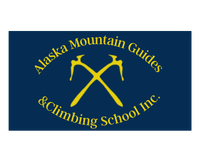
Backpacking
From exploring the intricate slot canyons of southern Utah, hiking the high mountain passes of Canada's Yukon Territory and delving into the Gold Rush history of Alaska's Chilkoot Trail, our backpacking and trekking trips throughout North America offer a premiere guided wilderness experience. We offer a wide scope of trekking, hiking and canyoneering trips from single day adventures to remote 12 day backpacking trips. Our guides have a unique love for wilderness and are accomplished naturalists whom enjoy sharing their passion for the outdoors.
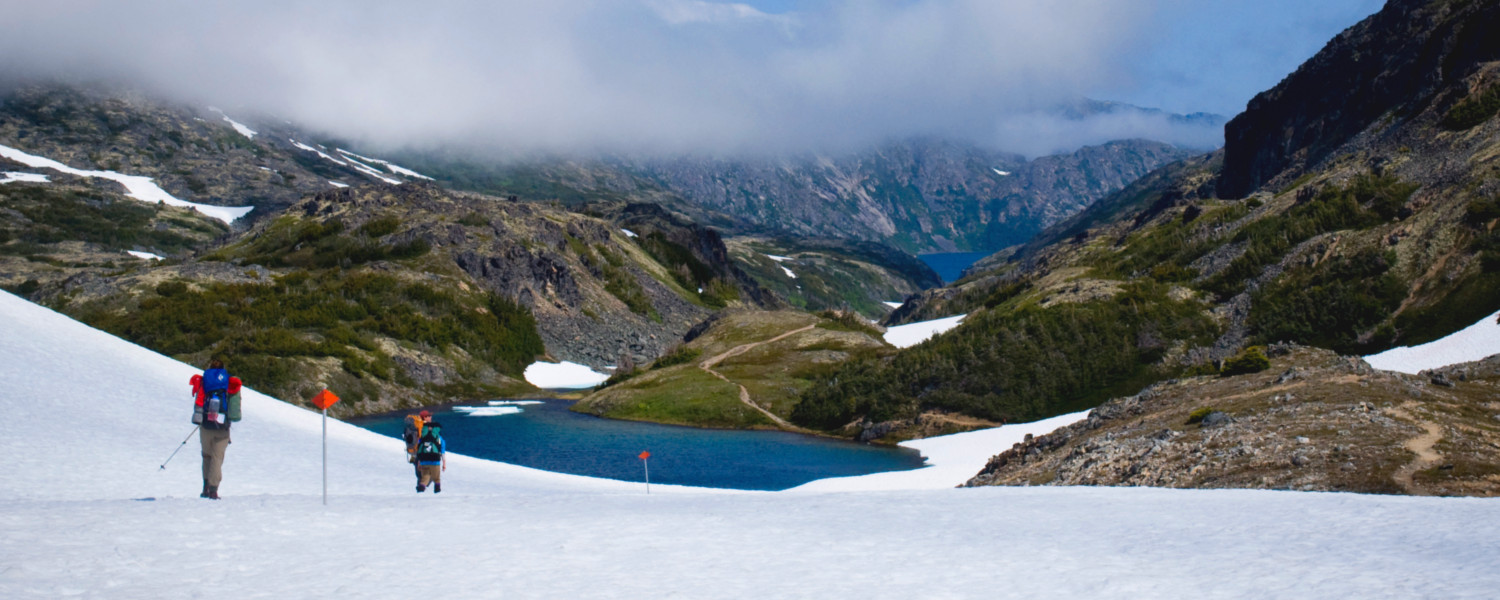
Search Trips
Meeting location, *starting from prices, per person, in usd, kongakut river, price: $9300*.

Raft the Kongakut River through the last great prehistoric wilderness in North America. Travel with the spring migration of the Porcupine Caribou Herd. Hike under the midnight sun. Experience the Arctic in its most pristine environment.
- Destination: Arctic National Wildlife Refuge
- Activity: River/Whitewater
- Difficulty: 3 out of 5
- Duration: 11 days
- Meeting Point: Haines, AK
- Operated By: Chilkat Guides
Trip Details
Haines Heli Skiing/Snowboarding
Price: $7975*.
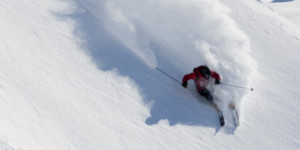
An unforgettable experience in one of the world's most iconic ski and snowboard destinations, in the most exclusive manner possible - via helicopter.
- Destination: Haines, AK
- Activity: Skiing/Snowboarding
- Duration: 7 days
Skagway Heli Skiing / Snowboarding
Price: $7600*.
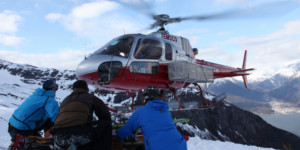
Join us for an exclusive heliski experience in Skagway, Alaska. Steep couloirs and powder runs abound!
- Destination: Skagway, AK
- Meeting Point: Skagway, AK
Heli-Ski Guide Training Course
Price: $7250*.

This heli-ski guide training course teaches aspiring ski guides the skills to manage ski descents, establish landing zones, assess terrain from the air, and the other technical skills essential for heli-ski guiding in Alaska.
- Destination: Glaciated Peaks surrounding Skagway
- Duration: 12 days
- Operated By: International Wilderness Leadership School
Alsek River Expedition
Price: $6300*.

From the big drop at “Lava North“, to the class-5 helicopter portage at Turnback Canyon, this river expedition leaves a lasting impression of the ruggedness of the north.
- Destination: Glacier Bay & Kluane National Parks
- Difficulty: 2 out of 5
- Duration: 14 days
Tatshenshini River Expedition
Price: $5500*.
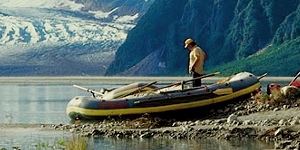
Grizzly Bears, Wolves, and Moose all call the Tatshenshini-Alsek Provincial Park home. For decades, the Tatsheshini River has been regarded as the classic Alaska/Canada transboundary wilderness trip.
- Destination: Glacier Bay & Tatshenshini-Alsek Provincial Park
- Duration: 10 days
Mt. Fairweather
Price: $4950*.
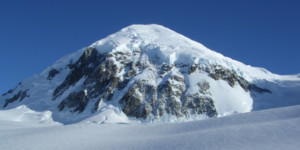
At 15,300' and the highest point in British Columbia, Fairweather stands proudly just 10 miles from the Gulf of Alaska. This moderately technical Alaska expedition offers climbers a great initial step into high altitude Alaska mountaineering.
- Destination: Fairweather Range
- Activity: Mountaineering
- Difficulty: 4 out of 5
Glacier Bay East Arm
Price: $3800*.
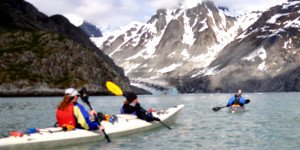
The East Arm of Glacier Bay National Park is home to one of the most prolific marine ecosystems in the world. Fjords teeming with wildlife, towering jagged mountain peaks, and stunning glaciers combine to create the paddling experience of a lifetime.
- Destination: Glacier Bay National Park
- Activity: Kayaking
- Duration: 8 days
- Meeting Point: Gustavus, AK
Glacier Bay West Arm
Price: $3550*.

Experience the magic of paddling among the icebergs in deep glacially carved fjords and alongside whales, then enjoy quiet nights under the stars in the jaw-dropping beauty of Glacier Bay's West Arm.
Whitewater leadership & guide training, price: $3465*.
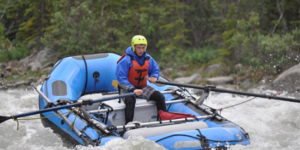
This 12-day intensive course teaches aspiring guides the technical skills for swift water rescue and rafting in class III and IV rivers. Students learn to row oar frames and paddle captain with hands-on learning.
- Destination: Rivers of the Yukon
Alpine Climbing
Price: $2190*.
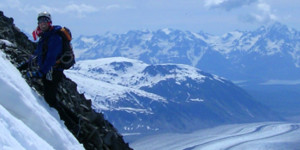
Join us as we explore the mountains surrounding Haines, AK. A trip designed for guests with some previous mountaineering experience to maximize on the world class climbing Haines has to offer.
- Duration: 7, 12 days
Expedition Primer
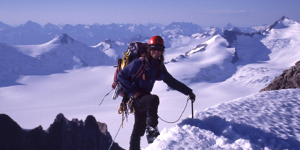
The Expedition Primer course is designed to take your climbing to the next level and helps prepare guests for challenging climbing expeditions such as; Denali, Aconcagua, and more!
Yukon backpacking leadership & guide training, price: $3250*.
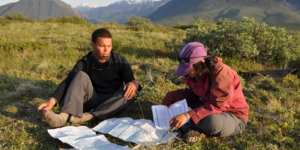
Guide training backpacking course into the wilds of the Yukon. This course takes place in Kluane National Park on the Donjek Route.
- Destination: Kluane National Park
- Activity: Backpacking
Glacier Bay Escape
Price: $3080*.
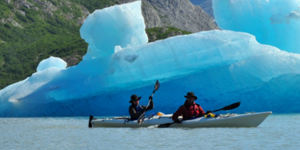
Explore Glacier Bay National Park on this 5-day sea kayaking adventure. Paddle between ice bergs, towering peaks and glaciers while enjoying numerous unique wildlife sightings.
- Duration: 5 days
Glacier Bay Exploration
See how the physical world shapes the biological with the succession of marine and terrestrial life flourishing in the wake of receding glaciers. the east arm of glacier bay national park, known for it's fjords teeming with wildlife, towering jagged mountain peaks, and stunning glaciers combine to create the paddling experience of a lifetime., donjek route, price: $2950*.

The Donjek route rises over the vast alpine of the Burwash Uplands and then descends to the toe of the Donjek Glacier. This route challenges routefinding and navigation skills and typifies this pristine mountain wilderness.
Backcountry skiing/snowboarding, price: $430*.

Earn your turns between nunataks and glaciers on a backountry ski tour through the Coastal Mountain Range surrounding Haines and Skagway, Alaska.
- Destination: Haines, Alaska
- Duration: 1, 3, 5, 7 days

Ski/Snowboard Leadership & Guide Training
Price: $2695*.

Learn to lead ski & snowboarding mountaineering objectives in Alaska. Hone your technical skills and develop leadership skills among the glaciated peaks of Alaska.
- Destination: Glaciated Peaks surrounding Haines or Skagway
- Duration: 12, 20 days
Mountaineering Leadership & Guide Training
Price: $2500*.
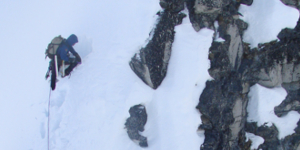
Learn technical snow, rock and ice skills to lead in the glaciated peaks of Alaska. Learn to lead your group through a crevassed icefall, ascend a rocky ridge with the clouds beneath your feet and dig a snow pit profile to assess the avalanche danger.
Intro to mountaineering, price: $2150*.
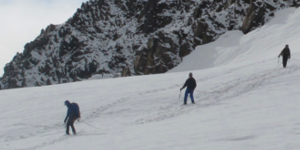
Join us as we explore the basic 101 of mountaineering. From tying in to a rope team to knots and anchor building, we'll teach you the important foundational skills of mountaineering.
- Destination: White Pass
Cottonwood Trail
Price: $2100*.
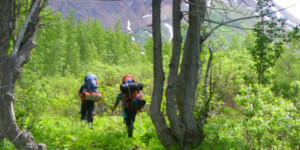
Keep the rugged ridgelines of the Dalton Range constantly in your sights as you wind through spruce and poplar groves, cross phenomenal mountain passes, and wander through alpine meadows.
- Destination: Kluane National Park and Preserve
Sea Kayak Leadership & Guide Training
Price: $1850*.

Students on an IWLS Alaska Sea Kayaking course will explore the incredible land- and seascapes of Southeast Alaska and learn the leadership and technical skills to lead kayaking expeditions.
- Destination: Glacier Bay or Lynn Canal
- Meeting Point: Haines, AK or Gustavus, AK
Fjords of the Inside Passage Kayaking
Price: $365*.
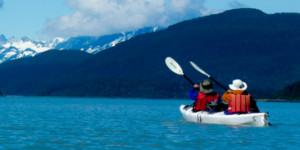
Explore the pristine tidal waters of the upper Lynn Canal and the Chilkat Peninsula. The surrounding islands, meadows and coves offer paddlers a remarkable Alaska marine wilderness with incredible wildlife viewing opportunities, glacier hikes, and secluded camps.
- Duration: 1, 3, 5 days
Alaska Rock Climbing Leadership and Guide Training
Price: $1800*.
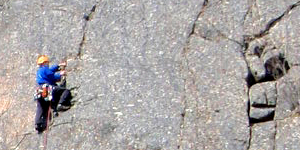
Develop technical skills in the vertical realm with our educational division, the International Wilderness Leadership School. Practice anchor building, multi-pitch techniques, and safe climbing skills on the granite of White Pass.
- Destination: Skagway area rock
- Activity: Rock/Ice
Whales of Point Adolphus
Price: $570*.

Kayak alongside humpback whales in gorgeous, nutrient-rich waters of the Icy Strait. Experience incredible wildlife viewing opportunities with some of the best whale watching in North America!
- Destination: Point Adolphus & Icy Strait
- Duration: 1, 3 days
Alpine Tundra Trek
Price: $1430*.
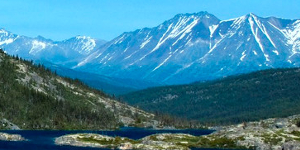
Trek within the boundaries of the largest protected wilderness area on the planet.
- Destination: Chuck Creek Trail & Mineral Lakes Loop
- Duration: 4 days
Chilkoot Trail
Price: $1400*.

Join Alaska Mountain Guides for a trip back in time, as we travel in the footsteps of the stampeders who traveled the Chilkoot Trail during the Klondike Gold Rush.
Upper tsirku river rafting, price: $1200*.
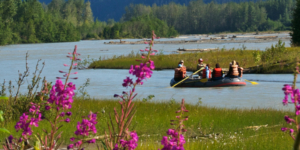
Join Alaska Mountain Guides for a spectacular wilderness river trip for two days on the Tsirku River. Located just outside of Haines, Alaska, its waters drain from the largest non-polar ice cap and largest protected wilderness area on the planet.
- Destination: Tsirku River & Chilkat Bald Eagle Preserve
- Duration: 2 days
Takshanuk Ridge Trekking
Price: $730*.

Mount Ripinsky and Takshanuk Ridge offers an iconic alpine ridge walk perched above the Chilkat Valley and surrounding fjord. A great, easily accessible multi-day Alaska backpacking adventure.
- Duration: 3 days
Rock Climbing
Price: $330*.
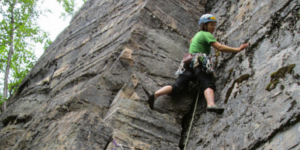
Expert guides will take you on a private trip. Climbs range from 5.0 through 5.11 with a variety of single and multi-pitch climbs. Towering snow-capped peaks and a lush coastal temperate valley make for a stunning backdrop.
- Destination: Porcupine Crag
- Duration: 1, 2 days
Blanchard Whitewater Rafting
Price: $275*.

Join us for a fantastic day-trip rafting on the Blanchard and Tatshenshini Rivers. This class III-IV whitewater trip offers paddlers a chance to enjoy fun rapids, while experiencing the beauty of the Yukon.
- Destination: Yukon Territory
- Duration: 1 days
Day Rafting Trips
Price: $150*.
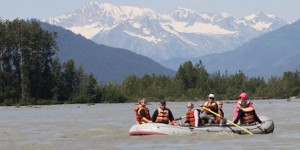
Explore the wilderness rivers on a day trip surrounding Haines and Skagway. Great wildlife viewing and perfect for families!
- Destination: Haines & Skagway Rivers
- Difficulty: 1 out of 5
- Operated By: AMGA
Day Kayaking
Price: $135*.
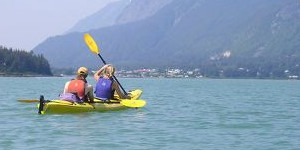
Explore coastlines and paddle through the waters surrounding Haines and Skagway, Alaska.
- Destination: Haines and Skagway, AK
Price: $95*

Hike historic trails, trek ridgelines in Alaska and the Yukon, and explore coastal inlets to alpine tundra!
Price: $5800*.

Discover an incredible climbing experience for individuals seeking the challenges of a high altitude climbing expedition in a spectacular setting by climbing Aconcagua, the tallest peak in South America.
- Destination: Cerro Aconcagua
- Duration: 20 days
- Meeting Point: Mendoza, Argentina
Rock Climbing Leadership and Guide Training
Price: $3125*.
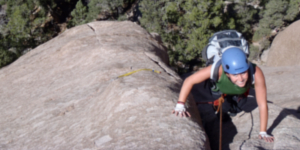
Climb multi-pitch rock routes in Utah's West Desert while learning the skills needed to guide top-roping and multi-pitch rock safely with the International Wilderness Leadership School.
- Destination: Utah's West Desert
- Meeting Point: Salt Lake City, UT
- Create Account
Signed in as:
- Backpacking Retreats
- Womens Summer Camp
- Hiking Adventures
- Climbing Retreats
- International Retreats
- Climb & Camp Weekends
- Intro to Outdoor Climbing
- Anchors and Rappelling
- Intro to Lead Climbing
- Climbing Movement
- Leading Trad
- Intro to Alpine Climbing
- Intro to Mountaineering
- Multi-Pitch
- Self-Rescue
- Intro to Backpacking
- Hire a Guide
Rock Climbing & Backpacking Clinics and Retreats
Our mission is to create an educational space for women (cis, trans) to realize their strength through outdoors retreats and skills clinics.
We offer a variety of programs catered to a wide range of skill levels, from complete beginners to experts.
Learn more about who we are and what we do here.
Rock Climbing Retreats
Backpacking retreats & clinics, international climbing trips, let's be friends.
Drop your email address here and stay in the loop with our monthly newsletter (think: early access to trips, insider season recaps, last-minute openings, and more!). We respect your privacy.
Shoutout To Our Sponsor
Copyright © 2020 She Moves Mountains - All Rights Reserved.
Powered by GoDaddy Website Builder
- Cancellation Policy
- Payment Plans
- Provided Gear
- Join Our Mailing List
This website uses cookies. By continuing to use this site, you accept our use of cookies.
Dedicated to your Adventure.
Professional mountain guiding since 1985..
Sawtooth Mountain Guides are your experts for climbing, hiking, backcountry skiing, and avalanche education near Stanley, Sun Valley, and Boise. Come experience the scenic Sawtooths and let us lead you on the perfect mountain adventure!
Choose your adventure
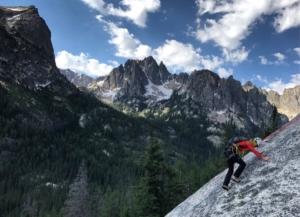
We have rock climbs and peak ascents for never-evers and hardcores alike.
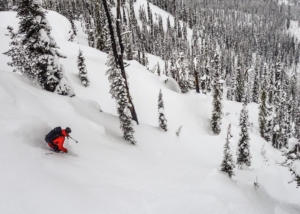
From powder glades to open bowls to rock-lined couloirs, we have terrain for everyone.
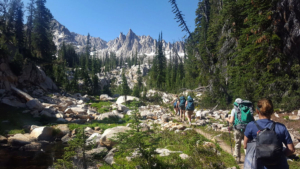
The Sawtooth Mountains are a world-class hiking and backpacking destination.
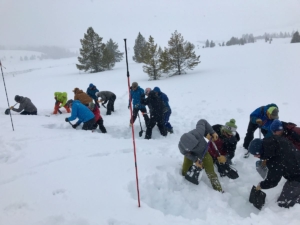
We're fanatical about the mountains and eager to pass on our knowledge to others.
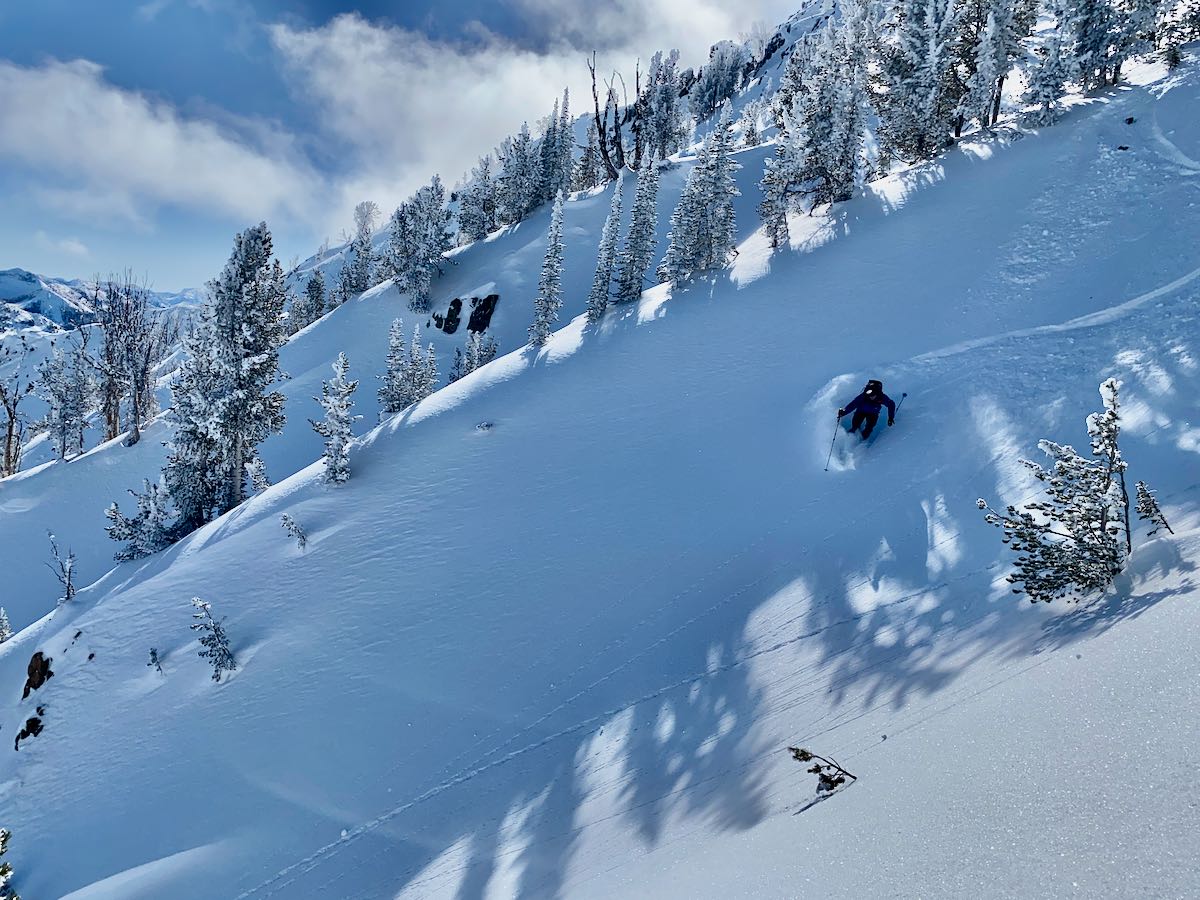
Our Mountains
Our extensive ski terrain ranges from the easily-accessible powder slopes and chutes of Galena and Banner Summits to the jaw-dropping ruggedness of the Sawtooth Range. Whether on a day trip or based at our comfortable hut, we have something for everyone.
Our Guides
Our guides have a winning combination of talent, training, and experience. We are the only guide service in Idaho to be accredited by the American Mountain Guides Association and our professional guides have been providing quality mountain experiences for 30 years.
Your Experience
All in all, an incredible day and I just booked another trip (the ultimate testimony!). Truly a 5 star experience.
P2463LWjasonc
6 stars if Trip Advisor would let me!
I’ve never done anything like it. The guides were awesome! So cool!
We have used different guides from other states and Sawtooth Mountain Guides is one of the best!
Joe_Cindy2014
These guys are the real deal. Terrain is unbelievable. Guides are fun to hang out with. Might have to just come here every year. Can’t say enough good things about these guys.
The entire experience was fun, challenging, personally meaningful. I came away feeling confident and incredibly proud of myself. I can’t wait to return for another adventure in the future!!
Sawtooth Mountain Guides is without a doubt one of the best guide services in the country. If you want the adventure of a lifetime, seek out these talented folks.
Trust this company to facilitate your outdoor adventure and prepare to be impressed! We had the BEST. TRIP. EVER.
No matter your skill level, a good mountain guide can always enhance the experience with local knowledge and helping you hone your abilities
Indiesurfer


The 8 Best Men’s Hiking Boots and Shoes for Any Terrain
17 testers tried 41 hikers. these came out on top..
Heading out the door? Read this article on the new Outside+ app available now on iOS devices for members! >","name":"in-content-cta","type":"link"}}'>Download the app .
Trail running shoes are the most popular footwear on-trail these days, which may lead you to think traditional hiking boots are on the way out. Our big test this year suggests something different: Most of the 41 models we tested proved emphatically that proper hiking boots and shoes make backpacking easier and more comfortable, protect our feet and ankles, and stick to roots, rocks, and dirt.
But the push to go fast does permeate the entire market these days, which is great. It means lighter weights, a nimbler feel, and smoother striding, no matter the style of boot. The very best hiking shoes and boots for men—the ones that made this list—will help you walk with less effort, leaving you more energy to go further and faster while savoring the journey along the way.
At a Glance
- Editors’ Choice: Saucony Ultra Ridge GTX ($190)
- For Backpacking: Lowa Trek EVO GTX ($340)
- For Carrying Heavy Loads: Meindl EuroLight Hunter ($295)
- For Scrambling: Zamberlan Salathe Trek GTX ($330)
- Best Mtn-to-City Hiker: Salewa Puez Knit PTX ($240)
- For Speed Hiking: Oboz Katabatic Wind ($185)
- For Weekend Hikes: Asolo Falcon Evo Jacquard ($240)
- Beefiest Low: Scarpa Moraine Low WP ($169)
- How to Choose the Right Hiking Boots
How We Test
All gear in this guide was tested by multiple reviewers. When you buy through our links, we may earn an affiliate commission. This supports our mission to get more people active and outside. Learn more .
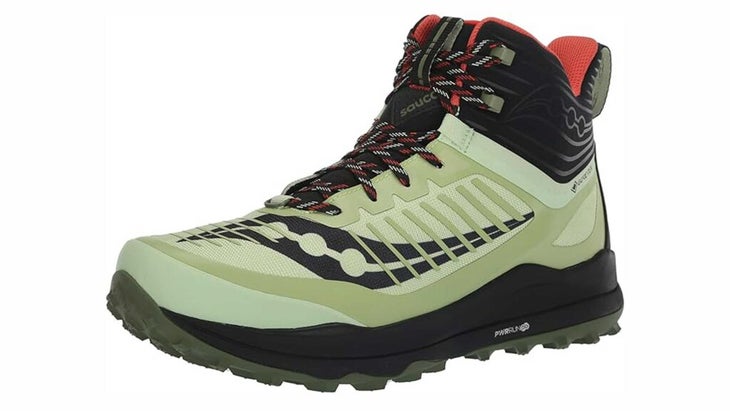
Editors’ Choice
Saucony ultra ridge gtx.
$190 at Amazon $190 at Running Warehouse
Weight: 12.6 oz (men’s) / 11 oz (women’s) Sizes: 7-15 (men’s) / 5-12 (women’s)
Pros and Cons ⊕ Lightweight ⊕ Springy trail runner fit and feel ⊗ Lacks backpacking support
Trail runner-based boots tend to skew in one direction or the other—either they’re too light to support heavy loads, but feel great at speed, or they’re too overbuilt to move fast. One of the lightest high-top boots we’ve ever tried, the Ultra Ridge GTX might just be the first fusion to hit the bullseye. “It’s as comfortable as the most comfortable running shoe, but with the ankle support of a light boot,” gushed tester Patrick Lowkes after a 17-mile hike and run through New York’s Tongue Mountain Range. A Pebax-based foam insert in the midsole—the same kind used in bouncy, marathon-racing super shoes—is remarkably comfortable and lively-feeling underfoot.
It never felt squishy or unstable thanks to a firmer EVA frame below and around the insert and a lightly padded high-top that provides lateral support. It excels over a variety of surfaces: an unobtrusive rock plate prevents bruising while a grippy, durable, chevron-studded outsole digs into mucky and slippery surfaces. Testing them through a soggy New England summer, Lowkes says the Gore-Tex liner didn’t overheat in humid, 75-degree weather, deflected all-day rain, and emerged from a four-inch-deep mud puddle unsodden.
And there’s year-round utility, too. Outside’s senior running editor, Jonathan Beverly, found there was enough ankle height to keep snow and slush from spilling over the top. Backpackers who kept their weight under 30 pounds loved the Ultra Ridge GTX, but the soft upper cuff doesn’t offer enough support for heavier loads. For trail runners headed into crap weather, the boot-averse, and anyone else who ranks weight and spring above all else, the Ultra Ridge GTX is the most comfortable and speedy hiker we’ve tried.
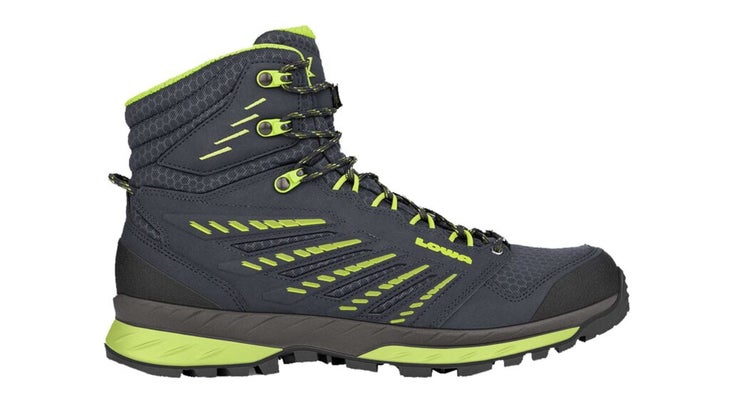
Best for Backpacking
Lowa trek evo gtx mid ($340).
$340 at Lowa Weight: 1.4 lbs (men’s) / 1 lb (women’s) Sizes: 7.5-14 (men’s) / 5-10.5 (women’s)
Pros and Cons ⊕ Excellent grip ⊕ Supportive ⊗ Expensive
Lowa calls the Trek Evo a fastpacking boot, but our testers swear its sweet spot is backpacking. It’s certainly energetic enough for moving quickly down the trail: For a six-inch-tall hiker, it’s relatively lightweight, thanks to an all-synthetic upper with just a thin TPU film for toe and heel protection. (Despite the lightweight construction, however, our sample still looks new after nearly 100-miles of testing.) Cutouts in the tongue and heel enhance the forward flex.
Even more impressive? As testers added pounds to their pack, the boots never wavered. The TPU midsole wrapped around the sides of the foot and worked with stiffer synthetic panels on the upper to cradle and support the ankle, while three open eyelets allowed micro adjustments. And the Vibram Rock Trac outsole provided reliable grip on a variety of surfaces, including rock edging and smearing. Climbing Vancouver Island’s Victoria Peak with a 30-pound pack, the boots provided a stable platform for mountain guide Bill Phipps. “They made me feel more confident, especially carrying a heavy load,” he says.

Best for Carrying Heavy Loads
Meindl eurolight hunter uninsulated.
$295 at Meindl
Weight: 1.5 lbs (unisex) Sizes: 7-14 in D width, 8-14 in EE
Pros and Cons ⊕ Weatherproof ⊕ Off-trail performance ⊗ Tall and heavy
As the name suggests, Meindl designed these 9-inch-tall boots for hunting— which means they’re stellar for heavy loads and bushwacking. After plodding along logging roads, rolling down trails, and scrambling up steep hillsides, our testers say the Eurolight Hunters stand out in how nimble they feel for such a burly boot. The waxed, full-grain Nubuck leather upper with eight lace eyelets reaches well above the ankle, and a polyurethane midsole creates a stable base to carry more than 50 pounds.
Despite all that stability, the Eurolight Hunter isn’t particularly stiff—cutouts in the leather along the tongue and in the achilles area and gusseting allow for more flex and fluid movement. They required only a couple of day hikes to break in and were easy to pull on and take off, says JF Marleau, a sea kayak guide who tested them in the B.C. Coast Range while hiking and hunting. Bashing around off trail, the outsole’s deep round lugs and sharp edges provided excellent grip and stability in a variety of on- and off-trail surfaces.
Even more impressive was the Gore-Tex waterproof-breathable liner. While the all-leather upper got sweaty in temperatures above 65 degrees or when going hard, this boot was impermeable. “It was raining, and I had to cross many creeks,” says Marleau. “At the end of the day, my feet were dry and happy.”
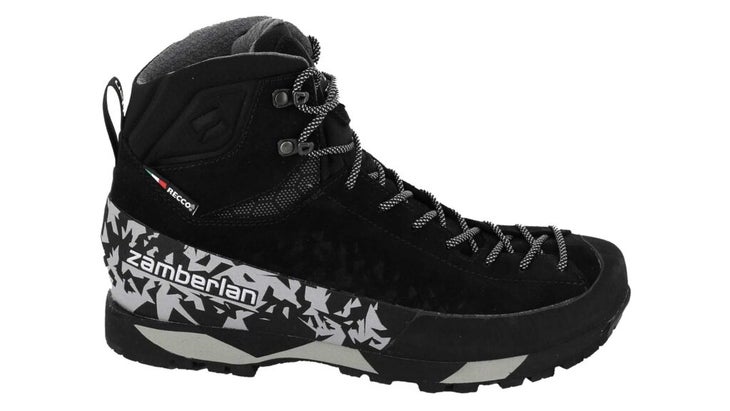
Best for Scrambling
Zamberlan salathe trek gtx.
$330 at REI
Weight: 1.1 lbs (unisex) Sizes: 7.5-13 (unisex)
Pros and Cons ⊕ Grippy ⊕ Waterproof ⊕ Durable ⊗ Expensive
Zamberlan’s Salathe Trek GTX is the new, mid-cut big brother of the popular Salathe approach shoe. The brand kept the foot-conforming suede upper (backed by a Gore-Tex liner), the to-the-toe lacing for a snug fit, a chunky Vibram outsole with smearing and edging sections, and a 360-degree rubber rand to protect against scree and rock gashes.
To handle pack weight and the uncertainties of route-finding, Zamberlan raised the ankle to six inches high with just a bit of foam for support. The extra height and waterproof membrane were appreciated in soggy conditions: The hydrophobic suede deflected melting snow while the Gore-Tex liner stood up to an all-day soaker. The liner also upped breathability, which was above average for an all-leather boot. (Testers noticed some clamminess above 65 degrees.)
To maintain walking flexibility, Zamberlan added a cutout at the ankle crease, which allows for natural motion in combination with a springy, lightweight, dual-density EVA midsole. “They felt light on my feet and springy on the ground,” says tester Jakob Schiller, who wore them scrambling in the Sangre De Cristo Mountains of New Mexico. There’s enough boot here for gear-intensive trips and backpacking, unless you load up with more than 35 pounds on the back, when an ankle roll starts to feel inevitable.
Otherwise, Schiller says, what stands out is the quality: thick suede leather, durable rubber rands, high stitch counts, and a resoleable design: “They’re built to last.”
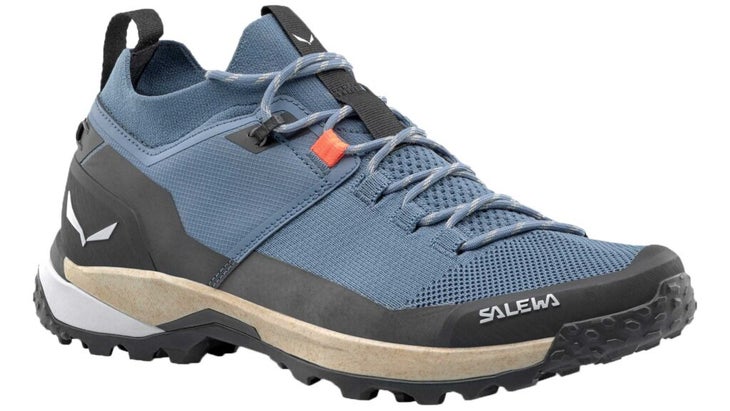
Best Mountain-to-City Hiking Shoe
Salewa puez knit ptx.
$240 at Salewa
Weight: 1 lb (men’s) / 13 oz (women’s) Sizes: 7-14 (men’s) / 6-11 (women’s)
Pros and Cons ⊕ Out-of-box comfort ⊕ Versatility ⊗ Not stable enough for backpacking
The Puez Knit PTX Low is the rare hiker that can pull double-duty on a variety of trails and blend in seamlessly around town. For folks who care more about utility than looks, the upper is a knitted nylon and ripstop polyester that stretches to create a conforming fit. A waterproof-breathable membrane and full wrap rubber rand add water and scuff protection. A dual-density EVA midsole (partially made with hemp) adds stiffness and cushioning.
Wearing them right out of the box, tester John Waters climbed a steep, muddy trail, crossed hard-packed summer snow, and scrambled up rock slabs to snag a Vancouver Island peak without even the suggestion of a blister or hot spot. The outsole has big, chunky lugs covering most of the shoe, with a smearing area at the toe. It’s a versatile combo that shed mud and stuck to slick rocks. “They have amazing grip and awesome stability for a shoe,” Waters says, although their low cut and softness meant they were not up to overnight loads.
For around town, one tester found that the PTX Low’s were the perfect traveling shoe, cushioning miles of pavement wandering. Their earth-tone hues and multi-textured fabric helped them blend into the background for wearing into restaurants and shops post-adventure.

Best for Speed Hiking
Oboz katabatic wind low.
$185 at REI $185 at Amazon
Weight: 12.3 oz (men’s) / 10 oz (women’s) Sizes: 8-14 (men’s) / 6-11 (women’s)
Pros and Cons ⊕ Cushy ride ⊕ Good value ⊗ No weather protection ⊗ Built for light-loads
As comfortable as a pair of runners, the Katabatic Wind Lows are made for going fast. Oboz borrowed tech from running shoes, including a forked carbon-fiber plate, nitrogen-infused foam (which is springier and more cushioned than typical EVA foam), and a rockered outsole. “So cushioned I never got sore feet and found myself wearing them all the time,” says Alabama-based tester Seth Kromis. On heel strike, the combo seemed to absorb energy, roll to the toe, and accelerate the foot into the next stride, says Kromis.
The mesh upper—highly breathable but not weatherproof at all—has TPU inserts along the forefoot for durability and in the heel for a touch of rigidity. “It’s the perfect balance of support and bounce that made me feel like breaking into a run,” says Bozeman-based Allison Bodznick, who used the shoes as trail runners and city walkers. The chevron-shaped tread pattern, enhanced by the proprietary sticky rubber compound, provided solid traction on a variety of surfaces. “I could feel the treads sticking to the ground like frog feet,” says Bodznick. These shoes are built for speed and will last a lot longer than trail runners, but watch that pack weight: even on a day hike, the Katabatic Wind Lows started to feel unsupportive when loads exceeded 20 pounds.

Best for Weekend Backpacking
Asolo falcon evo jacquard gv.
$240 at REI $240 at Asolo
Weight: 1.1 lbs (men’s and women’s) Sizes: 7.5-13 (men’s) / 6-10.5 (women’s)
Pros and Cons ⊕ Lightweight ⊕ Waterproof ⊗ Poor grip in gravel
Don’t let the mid-height of these boots fool you—the Falcon Evo Jacquard GV’s are speed demons. For one, they’re lightweight, weighing eight ounces less than similarly-constructed hikers, thanks to a feathery woven polyester blend rather than suede or leather, and a coating of polyurethane along the base of the upper in lieu of a rubber rand. Webbing daisy chain eyelets and just a thin bit of foam cushioning around the heel and tongue cut even more weight.
The exception to the gram-counting? The midsole: A dual-density EVA that provides solid cushioning and stability. “They’re extremely comfortable,” says Lindsay Elms, who tested the boots over 30 miles of running, hiking, and mountain climbing around his home on Vancouver Island. “The boot responded well to quick changes in rough terrain and was malleable without being too soft.” There’s just enough structure for light backpacking and off-trail day hikes carrying up to 30 pounds.
Elms found the Vibram Megagrip outsole worked well in mud, dirt, and rock, but was less predictable in loose gravel and sand. The Gore-Tex liner, which rises nearly to the top of the boot, keeps feet dry when low cut shoes would be underwater. Durability is solid, but we don’t expect the lightweight material mix will hold up over the long term compared to the other mids in test—an acceptable tradeoff for such a lightweight boot.
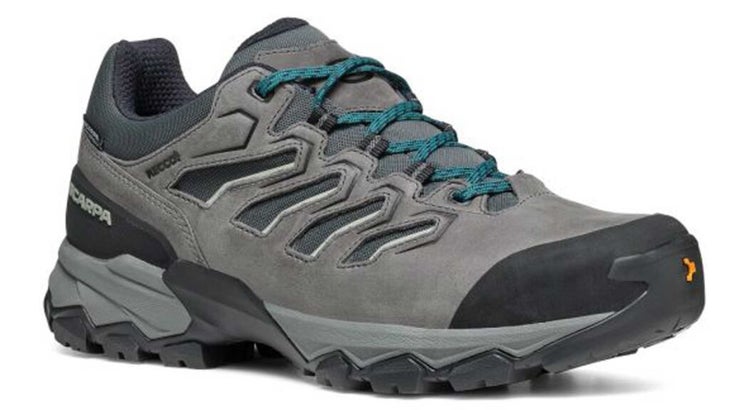
Beefiest Low-Top
Scarpa moraine low wp.
$169 at Scarpa
Weight: 1.4 lbs (men’s) / 1.1 lbs (women’s) Sizes: 7-13 (men’s) / 6-10 (women’s)
Pros and Cons ⊕ Stability ⊕ Built-in RECCO locator ⊗ Heavy
Opting for an airy low-top doesn’t necessarily mean less stability and protection than a tall boot. The Moraine Mid WP is prime example: In addition to dual-density EVA cushioning, Scarpa added a nylon medial shank and a stiff TPU counter to the shoe, which wraps high around the heel. The Moraines don’t have the bouncy feel of a speedier hiker—they feel quite stiff, in fact—but compensate by smoothing out uneven ground and providing a surprising amount of ankle support for a low-cut hiker.
“They have boot-sized stability without the clunk,” says category manager Ryan Stuart. “After hard hikes, the added protection left my legs feeling fresher.” He found the Moraines were most at home on day trips, but he didn’t wish for taller boots (the Moraine comes in a mid height as well) while hauling a 25 pound load into Cream Lake on Vancouver Island or route-finding in Coast Range scree. And on a rainy fall hike, the oiled nubuck leather and recycled mesh upper, backed by a waterproof-breathable membrane, kept his feet dry. After more than 50-miles of use, the Moraine Low WP’s showed no signs of wear.
How to Choose the Right Hiking Boots
The most important consideration for hiking boots is fit. They should feel snug (but not tight) everywhere except around the toes, where you want a little extra room to accommodate foot swelling and to keep piggies from hitting the end of the shoe on downhills. All footwear brands come with their own idiosyncrasies—finding the exact right fit will take trial-and-error. So it’s best to try boots on before purchasing. Ideally, go to a brick-and-mortar retailer later in the day when your feet have swelled a little. Bring your favorite socks and a footbed if you prefer an after-market one. Once you’ve found a pair that seems to fit, resist the urge to hit the trail right away. Instead, wear them around the house for a few hours. This will give you an early sense of any issues while retaining the option of returning them.
Hiking Style
Before you start trying pairs on, think about the type of hiking you’ll be doing. For light and fast hiking, a lower cut and softer, more flexible midsole is preferable. For heavy pack loads or mountainous terrain, an above-the-ankle boot and stiffer midsole may work better. These burlier boots often have shanks and heel counters, which add even more rigidity and support. Many boots and trail runners also come with a rock plate for protection from bruising on sharp trail protrusions.
Environment
Finally, focus on trail conditions and environment. For rainy or wet trails, a waterproof membrane will keep your feet dry. For a dedicated summer hiker or for hot and dry conditions, a mesh boot will breathe considerably better and dry out quickly. Turn the boot over and look at the outsole pattern. Most lug patterns offer versatile grip, but in general, wet trails benefit from a deeper and wider lug pattern, which digs into and sheds mud better. A sharp inside edge and lug-less smearing zone around the toe help with scrambling on rock and slabs.
- Number of testers: 17
- Number of products: 41
- Number of miles hiked: Pushing 700
- Number of peaks climbed: 23
Mostly we just let our testers do what they do best: walk. We called in 41 different hiking boots and shoes and handed them out to 17 testers with instructions to put on some serious miles. They took short hikes and 30-mile backpacking trips, on-trail and off. They scrambled up peaks and down canyons, logging more than 700 miles in total. As they trekked along, we asked them to consider everything from fit to grip, cushioning to stability. Because pack weight can influence all these variables, we had them hike with both light loads and heavy packs. And to understand how boots and shoes performed in different weather conditions and environments, we spread testers and samples across the continent, from coastal British Columbia to New England’s windy summits.
Meet Our Lead Testers
Ryan Stuart has been lacing up for more than 30 years. Growing up in Alberta, Canada, he started hiking as a teenager on the world class trails of Banff National Park, before moving on to the coastal hikes and lonely mountain trails of Vancouver Island, where he now lives. His hiking resume spans the world, from Australia to Ireland, northern Canada to the U.S. southwest.
Lindsay Elms was running ultra races and knocking off Fastest Known Times long before they were trendy. Originally from New Zealand, he’s lived on Vancouver Island for more than 30 years. He reckons he logged more than 50 hours of trail time testing hiking boots this year.
Podcaster and photographer Adam Sauerwein (@mradamx) lives out of his van, which makes it easy for him to do a lot of hiking. Like a lot. The host of The Pursuit podcast, he estimates he trekked more than 250 miles in two months of testing, mostly in upstate New York, but also in Pennsylvania and Arizona.
When you buy something using the retail links in our stories, we may earn a small commission. We do not accept money for editorial gear reviews. Read more about our policy.
Popular on Backpacker
Related content from the outside network, what’s it like to go on a 200-person hike better than you think., how to pack for backcountry skiing, the original yosemite firefall, hiker charges mountain lion.

The Colorado Sun
Telling stories that matter in a dynamic, evolving state.
Worldwide backpacking trip shaped Rachel Gross’ deep look at outdoor gear

Share this:
- Click to share on Facebook (Opens in new window)
- Click to share on Reddit (Opens in new window)
- Click to share on X (Opens in new window)
- Click to email a link to a friend (Opens in new window)

Rachel S. Gross is a historian of the outdoor industry and author of “Shopping All the Way to the Woods: How the Outdoor Industry Sold Nature to America” (Yale University Press, 2024). She is an assistant professor of history at the University of Colorado Denver where she teaches U.S. environmental, business, and public history.
SunLit: Tell us this book’s backstory. What inspired you to write it? Where did the story/theme originate?
Gross: I went on a yearlong backpacking trip around the world at 22. It turns out the packing list I had so carefully assembled and the clothes and equipment I thought would keep me warm and dry were so very American. Not just the brands I sported — REI, Patagonia, Smartwool — but the ideas behind the gear: how to layer, how to deal with the rain, how to eat on the trail, the idea that “cotton kills.”
🎧 Listen here!
Go deeper into this story in this episode of The Daily Sun-Up podcast.
Subscribe: Apple | Spotify | RSS
Reading adventure fiction and scouting handbooks in my childhood had shaped my experience as a young adult traveler more than I realized. I had bought into those ideas, believed that there was a Right Way to dress and equip myself, just as much as the folks I was encountering around the world believed in a different Right Way. Over many miles, I reflected on why I thought acquiring the right gear would turn me into the person I wanted to be. Where did my packing list come from? Though I didn’t know it at the time, these questions would shape my academic research for the next decade.
SunLit: Place this excerpt in context. How does it fit into the book as a whole? Why did you select it?
Gross: World War II radically reshaped the outdoor industry. The preceding couple of chapters look at the U.S. military’s equipment and clothing program and how that spread around the country through army surplus. This excerpt follows those chapters. I selected it because it shows how Colorado was a hub of innovation in the outdoor industry in the 1950s and beyond.
SunLit: Tell us about creating this book. What influences and/or experiences informed the project before you sat down to write?
Gross: There are two important influences that informed the project before I sat down to write.
First, my childhood: Family road trips when I was a child shaped my romantic association with the wild and with mountains in particular. When I was 10 or 11 I longingly read my brother’s “Boy Scout Handbook” and ticked off the merit badges I imagined I would have earned if only I had been eligible to join that club.
UNDERWRITTEN BY

Each week, The Colorado Sun and Colorado Humanities & Center For The Book feature an excerpt from a Colorado book and an interview with the author. Explore the SunLit archives at coloradosun.com/sunlit .
Ms. Guth’s 11th-grade history class introduced me to Rocky Mountain School painter Albert Bierstadt and his oversized canvases of sublime mountain beauty in Yosemite. Camping trips with my parents and siblings in western national parks taught me how to set up a tent, poke at a fire, and wear a hat to keep warm at night. For an urban upbringing, my young adult life was full of messages that the mountains were where to go to feel real. I listened to books on tape like “Hatchet” and “My Side of the Mountain,” where courageous boys (always boys) lived in trees and learned the ways of the woods.
Second, after college I had a Thomas J. Watson Fellowship, which supported a year of backpacking around the world so I could pursue the project, “Mountain Hut Systems and the Meaning of Wilderness.” Traveling in wild places in other countries introduced me to how outdoor recreation culture operated there and showed me what very American assumptions I brought with me to the trail.
SunLit: What did the process of writing this book add to your knowledge and understanding of your craft and/or the subject matter?
Gross: I have no illusions about my craft being a solitary endeavor. This is a monograph but it was a team of supporters that brought me to the finish line. The scholarly process of individual work is driven by peer feedback. Conference presentations and talks, and even more importantly, writing groups, pushed me to expand the context I included, sharpen arguments, and bring what was in my head onto the page. Even the lonely archives were made a little less so by the friends who were there doing their own research at tables nearby.
This process means a broader, more interesting book: When a mentor at the Smithsonian passed on a copy of Kephart’s “Camping and Woodcraft” early on in my research, I didn’t just get a copy of an old book. I also learned how outdoor knowledge got shared and passed down. When a very smart reader reflected on their wearing of Army-Navy clothing, I knew I had to integrate that phenomenon into the surplus chapter.
SunLit: What were the biggest challenges you faced in writing this book?
Gross: Working consistently over many years was the biggest challenge. Writing was punctuated by big moves, new jobs, and many semesters of teaching. I didn’t always maintain focus on the book through all of those changes and activities, but I did always come back to it.
SunLit: What’s the most important thing — a theme, lesson, emotion or realization — that readers should take from this book?
“Shopping All the Way to the Woods”
>> Read an excerpt
Where to find it :
- Prospector: Search the combined catalogs of 23 Colorado libraries
- Libby: E-books and audio books
- NewPages Guide: List of Colorado independent bookstores
- Bookshop.org: Searchable database of bookstores nationwide

SunLit present new excerpts from some of the best Colorado authors that not only spin engaging narratives but also illuminate who we are as a community. Read more.
Gross: Some readers approach this topic with a misplaced nostalgia for a simpler time when the outdoors wasn’t so consumerist. I hope they realize through this history that that time never existed. Instead, the book shows that the outdoor industry developed in tandem with outdoor recreation itself. American outdoorspeople from 100 years ago had many of the same anxieties about buying too much gear getting in the way of their authentic engagement with nature.
SunLit: Walk us through your writing process: Where and how do you write?
Gross: The book was written in Madison, Wisconsin; Missoula, Montana; Munich, Germany; and Denver, Colorado. The research included visits to more than 25 libraries and archives (including corporate archives) in more than 10 states. I have been at work on the book since 2011. This matters because I write all over: quiet libraries, noisy coffee shops, with bad posture on my couch. I write meandering paragraphs to play with ideas and in furious fits to meet deadlines.
SunLit: What’s the best outdoor brand?
Gross: I never answer this question in the way that people would like. There is no best outdoor brand, of course. What gear works depends on where you live, what activities you are doing, your budget, and more. But the question itself is interesting to me, because it reflects a desire to rank brands, to ask a supposed expert for insider knowledge.
Any contemporary reader who is wondering about this shares much with the historical actors in my book who considered how what they wore would reflect on their identities. That’s a delightful connection across eras that I like to point out.
SunLit: Tell us about your next project.
Gross: Fifty years ago, the Denver Urban Renewal Authority razed a mostly Chicano neighborhood adjacent to downtown to build the Auraria higher education campus. Displaced Aurarians have been fighting to tell the story of their community ever since. As a public historian, I work with a community group to give history tours of the campus and put on public events to share the story.
A few more quick questions
SunLit: Which do you enjoy more as you work on a book – writing or editing?
Gross: Editing
SunLit: What’s the first piece of writing – at any age – that you remember being proud of?
Gross: A jointly written paper on the Treaty of Guadalupe Hidalgo, with my best friend, in 11 th grade
SunLit: What three writers, from any era, would you invite over for a great discussion about literature and writing?
Gross: Jane Austen, Robert MacFarlane, Arkady Martine
SunLit Do you have a favorite quote about writing?
Gross: “ Kill your darlings.”
SunLit: What does the current collection of books on your home shelves tell visitors about you?
Gross: I have an eclectic approach to organization.
SunLit: Soundtrack or silence? What’s the audio background that helps you write?
Gross: Silence.
SunLit: What music do you listen to for sheer enjoyment?
Gross: Musicals.
SunLit: What event, and at what age, convinced you that you wanted to be a writer?
Gross: I suppose I listen to outside voices for affirmation. Mrs. Frost, my third grade teacher, told my mom I should be a writer and she always reminds me of that.
SunLit: Greatest writing fear?
Gross: I have nothing new to say.
SunLit: Greatest writing satisfaction?
Gross: Making people laugh.
Type of Story: Q&A
An interview to provide a relevant perspective, edited for clarity and not fully fact-checked.
This byline is used for articles and guides written collaboratively by The Colorado Sun reporters, editors and producers. More by The Colorado Sun
latest in US News

'Guerrilla journalist' says he was beaten by anti-Israel...

Hochul refers upstate NY DA to commission that investigates...

DeSantis expected to campaign for Trump after pair meet in Miami:...

Hotel in trendy NYC neighborhood quietly converted into shelter...

NYC firefighter, 36, dies of heart attack after being fired to...

Harvard anti-Israel protesters fly Palestinian flag in spot...

Beloved pooch hit by stray bullet in NYC home dies of injuries:...

Columbia students celebrate as school officials promise no...
New york trans advocate, forest ranger falls to her death while ice climbing alaska mountain path ‘the escalator’.
- View Author Archive
- Email the Author
- Get author RSS feed
Contact The Author
Thanks for contacting us. We've received your submission.
Thanks for contacting us. We've received your submission.
A longtime New York forest ranger and trans advocate was killed Thursday night after falling more than 1,000 feet while attempting to climb a steep cliff in Alaska, officials said.
Robbi Mecus, 52, of Keene Valley and her climbing partner both fell while ice climbing an especially treacherous part of Mount Johnson in Denali National Park known as “the Escalator,” according to the National Park Service.
Mecus, a transgender woman, died in the fall. Her climbing partner, a 30-year-old woman from California, survived with “serious traumatic injuries.”

Another climbing party witnessed the tragic drop and called for help around 10:45 p.m., but it took until 7 a.m. the following morning for the survivor to be airlifted to a hospital.
Mecus’s body wasn’t recovered until Saturday morning following deteriorating weather conditions the evening prior.
The outdoors enthusiast had been a forest ranger for the Department of Environmental Conservation’s Adirondack region for 25 years after joining in 1999 at the age of 27, the agency said.
“I join the Department of Environmental Conservation family in mourning the sudden and tragic passing of Forest Ranger Robbi Mecus,” interim DEC Commissioner Sean Mahar said in a statement Saturday.
Mahar said Mecus “exemplified the Forest Rangers’ high standard of professional excellence,” emphasizing her rescue efforts, her work on complex searches and her deployments to out-of-state wildfire response missions.

The interim commissioner also commended Mecus’s work in “advancing diversity, inclusion, and LGBTQ belonging throughout the agency.”
Mecus was also a leader in the queer community in the Adirondacks, NCPR reported.
She told the outlet in 2021 that she struggled through her teenage years to come to terms with her gender identity. She ultimately waited until she was in her 40s to transition: “I was scared and afraid and I didn’t know how I was going to live my life.”

That hard time is when she discovered her love of rock and ice climbing, and opened her up to a community that didn’t include many queer people, allowing her the opportunity to become a leader.
“There are many reasons I didn’t come out until I was 44, but one of them was because I didn’t see anybody else doing the things that I still wanted to do and I didn’t think I could do them,” said Mecus in 2021. “I didn’t see any queer rangers. I didn’t see any trans climbers.”
According to her social media channels, Mecus had visited Alaska several times for expeditions over the years.

She even successfully made it up “the Escalator” last year.
It’s not clear what went wrong with her final climb, but park officials warn the path to Mt. Johnson’s 8,400-foot peak is among the most dangerous.
“The approximately 5,000-foot route involves navigating a mix of steep rock, ice, and snow,” the National Park Service said.
Mecus is survived by her daughter and former wife, who live in the Keene Valley community.
Denali National Park and Preserve is about 240 miles north of Anchorage.
Share this article:

Advertisement
More From Forbes
Is innsbruck europe’s new summer fun capital.
- Share to Facebook
- Share to Twitter
- Share to Linkedin
Austrian pro Peter Kaiser flips over the Alps at the annual Crankworx gravity-fueled mountain bike ... [+] festival at Bikepark Innsbruck. (Photo by Dean Treml)
Hosting the Winter Olympics in 1964 — and again in 1976 when Denver backed out after originally securing the games — transformed Innsbruck into a superstar for snow and ice sports.
It’s still a great place to downhill and snowboard, ski touring through the backcountry, fly off the end of the colossal ski jump, attempting a figure skating spin on a local ice rink or — if you dare — flying off the legendary Bergisel (“Ice Mountain”) ski jump.
But over the past few decades, the Austrian city has emerged as a summer fun capital too, one of the best places in Europe for hiking, biking, climbing, river sports, and even motorized off-roading.
Here are a few ways to get your adrenaline pumping this summer in and around Innsbruck.
You never know who you're going to meet while hiking the Karwendel mountain range north of ... [+] Innsbruck. (Photo by Sean Gallup)
Hike To Your Heart’s Content
Those who want to hike Innsbruck are confronted with a huge problem. Not the altitude or the steepness of some paths, but deciding exactly which trail you’re going to follow. The choice is mind blowing.
The popular AllTrails hiking app describes and maps 55 trails in and around Innsbruck and more than 400 walking routes in the surrounding region.
A great way to start is riding the double Nordkette cable cars to the summit of Hafelekar mountain (a.k.a. the “Top of Innsbruck”), where a short walk from the top station leads to panoramic views of the Inn Valley and the Austrian Alps, with southern Germany and northern Italy in the hazy distance.
Microsoft Warns Windows Users Of Ongoing Russian Hack Attack
New apple id password reset issue hitting iphone ipad and macbook users, new ios 18 ai security move changes the game for all iphone users.
From there you can continue along the Goetheweg trail along the crest of the Nordkette range to the Pfeishütte mountain hut, a roundtrip of roughly 8.4 miles (13.5 km).
The Goetheweg forms a small part of three far more challenging hiking routes that you can hop onto from Innsbruck: the new Karwendel High Trail (43 miles/70 km) through the Alpine wilderness north of Innsbruck and the epic Europe E4 hiking path that runs more than 7,500 miles (12,090 km) from southern Spain all the way through the Alps and the Balkans to Greece.
The iconic walk south of the Inn Valley is the 70-mile (120-km) Stubai Hohenweg trek through the Alps between Innsbruck and the Italian border.
Cycling through the Inn Valley during the annual Tour of the Alps race. (Photo by Reinhard ... [+] Eisenbauer)
Design Your Own Tour de Alps
Whether you’re a leisurely biker or an adventurous cyclist, Innsbruck offers two-wheel choices for just about everyone.
Regular and e-bike rentals for road and off-road cycling are available at numerous outlets in and around the city. Routes range from flat, easy bike paths on both sides of the River Inn in the city center to marathon Innradweg road cycling route that meanders 320 miles (520 km) through the Alps.
Once the snow melts, Bikepark Innsbruck takes over the Muttereralm snow sports area on the valley’s south side. The park features seven forest and mountain trails, a pump track and dual slalom course, a special area for kids and beginners, and access to a 13-mile (21-km) long-distance mountain biking route to three Alpine huts with food and drink.
Innsbruck’s public transport and cable cars convey cycles and the many biker friendly hotels provide secure storage and bike washing areas. The city also hosts the Crankworx gravity-fueled mountain bike festival in June, an event that attracts top riders from around the globe.
The Tyrolean Alps around Innsbruck boast hundreds of peaks and rock wall climbing faces. (Photo by ... [+] Arterra)
Alpine Mountain Highs
Avid peak baggers use Innsbruck as their basecamp for conquering the many Alpine summits that bookend the city on north and south. Among the region’s 90 multi-pitch routes is the intimidating and often snow-topped Hohe Munde (“High Mouth”), a gigantic peak that towers 8,733 feet (2,662 meters) above the Inn Valley.
More than two dozen sports climbing areas include cliffsides pitches besides the River Inn and precipitous rock faces near the middle Nordkette cable car station. Veterans and beginners can perfect their technique at four indoor climbing centers that operate year-round.
In addition, there are 10 do-it-yourself Via Ferrata routes in the Innsbruck region — high-altitude routes that include permanent steel ladders and cables to assist climbers.
Hauspfandl pork medallions with spaetzle noodles) at the 600-year-old Weisses Röessl restaurant in ... [+] the Innsbruck old town.
Après Sweat
Post hiking, biking and climbing, Innsbruck offers a lot of cool spots to refresh and refuel.
A half-hour hike through the woods from the bottom Nordkette cable car station, Umbrueggler Alm mountain hut restaurant complements its panoramic views with hearty Austrian dishes like wiener schnitzel and frittatensuppe (pancake soup) on a sun-splashed outdoor patio.
Down in the old town, drink in the awesome views and the craft libations at the 360° Bar, a spectacular glass-enclosed café/lounge on the roof of the RathausGalerien on Maria-Theresien-Straße. The prosecco and Lillet blends are especially tasty.
For a slice of history, dine at the Weisses Röessl (“White Stallion”), founded around 600 years ago and the only remaining of four restaurants that once graced the old town’s Vier-Viecher-Eck (Four Beasts Corner). Many of the dishes are also oldies-but-goodies: schöps pfannenbratl (lamb stew), hauspfandl (pork medallions with spaetzle noodles), and Tiroler ghröstl (roast potatoes with a fried egg and bacon cabbage salad).
If you’re staying two or more nights in Innsbruck between May 1 st and October 31 st consider investing in a Welcome Card , which includes free public transportation in the city and region, 24 hours of free rental bike, free guided hiking and e-bike tours, and discounts on many activities and attractions.

- Editorial Standards
- Reprints & Permissions
2-FOR-1 GA TICKETS WITH OUTSIDE+
Don’t miss Thundercat, Fleet Foxes, and more at the Outside Festival.
GET TICKETS
BEST WEEK EVER
Try out unlimited access with 7 days of Outside+ for free.
Start Your Free Trial
Powered by Outside
French Dominate Moscow Comp
Heading out the door? Read this article on the new Outside+ app available now on iOS devices for members! >","name":"in-content-cta","type":"link"}}'>Download the app .
Sandrine Levet won her second World Cup in a row while Jérôme Meyer narrowly won the men’s crown for a French sweep of the Moscow Bouldering World Cup. Levet, the two-time overall World Cup champion in bouldering, climbed one more problem than Anna Stör of Austria, a 16-year-old who was fourth in her only previous World Cup. Russian hopeful Olga Bibik, currently ranked second in the world in bouldering, finished a disappointing 10th. Meyer, who was third in this year’s first World Cup, in Birmingham, England, narrowly beat the Italian Christian Core for the victory in Moscow. Both men only completed two of the six problems in the final round, with Meyer needing two fewer tries. The veteran star Salavat Rakhmetov, 37, put on a good show for the home crowd, finishing fourth. Mark Croxall, the Brit who won the Birmingham World Cup, managed only 31st place in Moscow. Russians dominated the Speed World Cup in Moscow as expected, filling all three podium positions in both men’s and women’s speed climbing. Evgueni Minatchev won the men’s comp, and Anna Saoulevitch took the women’s laurels. The next Bouldering World Cup is in June in Italy, while the lead-climbing World Cup season kicks off in two weeks in Bulgaria. Men’s Bouldering 1. Jérome Meyer (FRA) 2. Christian Core (ITA) 3. Kilian Fischhuber (AUT) 4. Salavat Rakhmetov (RUS) 5. Ludovic Laurence (FRA) Women’s Bouldering 1. Sandrine Levet (FRA) 2. Anna Stöhr (AUT) 3. Emilie Abgrall (FRA) 4. Mélanie Son (FRA) 5. Maud Ansade (FRA)
Popular on Climbing
>", "path": "https://www.climbing.com/videos/7-greatest-climbing-punts/", "listing_type": "recirc", "location": "list", "title": "seven of the all-time greatest climbing punts"}}'> seven of the all-time greatest climbing punts, >", "path": "https://www.climbing.com/gear/best-climbing-hardware/", "listing_type": "recirc", "location": "list", "title": "this year’s best climbing hardware"}}'> this year’s best climbing hardware, >", "path": "https://www.climbing.com/videos/bad-belay-causes-climber-ground-fall/", "listing_type": "recirc", "location": "list", "title": "weekend whipper: don’t make promises you can’t keep"}}'> weekend whipper: don’t make promises you can’t keep, >", "path": "https://www.climbing.com/people/how-to-measure-ape-index-climbing/", "listing_type": "recirc", "location": "list", "title": "your ape index and 10 other really super important measurements"}}'> your ape index and 10 other really super important measurements.

How to travel by bicycle in Russia: ideas and suggestions
- April 15, 2021
- Last updated: April 19, 2021
- Adventure , Destinations , Outdoor , Russia
Home » Travel Blog » How to travel by bicycle in Russia: ideas and suggestions
Day trips in Russia
Newcomers can test their “strength” on a one-day trip – the roads should not be complicated and the distances should not be too long. For first-time riders, study the route carefully, taking into account not only the length of the road, but also the conditions: there should be no long climbs and no high mountain passes. The flatter the road, the better. Do not ride close to crowded and busy large traffic lanes, even if conditions permit. Also, make sure carry your Russian invitation letter with your visa .
Route: Levutov – Pavlovsky town
Distance: 65 km
From Reutov (metro station “Novokosino”) outside Moscow, via Saltykovsk, Zheleznodorozhny, Fedurnovo, then turn to Biserovo, to Staraya Kupavna, then to Elektrostal via Ivashevo, and finally to Pavlovsky Posad via Subbotino, the intercity electric train This is a good route for newcomers to the town of Pavlovsky Posad (Vokhna or Pavlovsky Posad station).
This route is good for beginners: the terrain remains almost unchanged throughout the route. It’s mainly asphalt, but it’s quiet, with a rural landscape and few cars. Also, there are many intercity train stations along the way – if you get tired, you can take the train back to Moscow.

For the uninitiated, there are plenty of suitable roads around Moscow. The entire Moscow region is dotted with railway lines, so it is not necessary to make a circular route. You can take an intercity train to one station and back from another. There are many convenient route options around most Russian cities. You can make your own route, or take the advice of experienced travelers and use an already prepared route map.
Two-day trips in Russia
If you can travel 60-70 km per day, it’s no problem and you’ll be able to ride for two days. First of all, you need to solve your overnight problem: will you stay in a hotel, borrow a private house or pitch your own tent? Be sure to take the weather into account and take extra things that will keep you warm or heated.
When choosing your route, add some “hills” on the way, but not too steep.
Keep an eye on your bike. Ideally, it should be carefully checked and tested two days before departure; if you don’t know much about bike parts, you should have a full “car check” at a good mechanic’s shop to remove all faults in time.
Read more inspiring articles:
- Cycling Medieval Towns in Costa Brava And The Pyrenees
- Train Travel in Europe with Interrail
- Packing List for Europe: The Ultimate Preparation Guide
- Best Hikes in the World: Europe
- Cycling In Costa Brava: All You Need To Know To Plan Your Trip
- Hiking in Portugal: Some of the Best Trails
Route: ride along Nizhny Novgorod and rest on the Volga
Distance: 140 km
This is a self-guided route with picturesque Volga forests, where you will have to pitch a tent on the road overnight. You don’t have to think about the schedule of electric trains or buses, even if you are delayed on the way, don’t worry.
From Nizhny Novgorod, you will pass through the town of Bor (you can cross the Volga by cable car). Next, head to Ivanovskoye. On the way, note the unique, interlocking bi-level railroad: it is no longer in use, but the original structure is still there. Then go in the direction of Yurasovo, where you will turn to Maloye Utkino, then to Beryozovka, to Vypolzovo, then to the Volga River, to Apraksino, passing through the hill fortress with its ancient earthen embankment. Hillfort, which retains its ancient earthen berm.
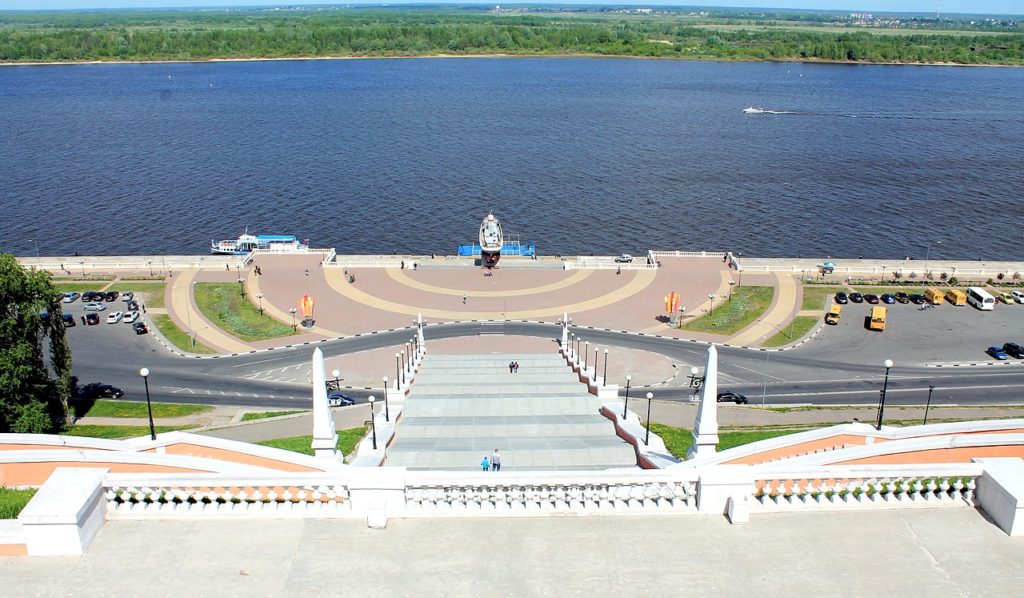
After that, follow Orlovo, Belkino, Yamnovo, Zavrazhnoye, Selishi. After passing through Zhukovka, you can go straight through the forest to the bank of the Volga River and find a place to pitch your tent.
The next day, go in the direction of Pumra, then through Vagankovo, Orekhovo, Markovo, turn left at Matveyevka, go to Vatoma, then through Put’kovo and back to the banks of the Volga, then to the town of Pol, and then to Nizhny Novgorod.
There are many suitable two-day rides in the Volga Valley, around the Voronezh region, around the cities along the Golden Ring and in the Crimean steppe.
Multi-day rides in Russia
Riding for several days in a row is a very serious matter and you need to be physically prepared. For the first time, choose a route that is not too difficult and not extreme, because riding a few days in a row is not at all the same as riding 100 km in a week. Please estimate that it is more comfortable to travel 70-80 km per day on the plains and with much less hills.
Check to see if there are any settlements along the way – it depends on whether you’ll be carrying a lot of food, or if you can buy all your food along the way. But whenever and wherever you go, make sure you have drinking water on you. Please do not forget to constantly replenish your supplies and have an emergency reserve – about 1.5 liters of water per person.
Route: “Crimean coast: from Kerch to Alushta”
Distance: 270 km , 5-7 days
We have intentionally divided the trip on this route into several days, as it depends a lot on your fitness and desire to visit the sights – which will be seen on the way, and quite a lot of them. There will be some mountain passes – if you feel tired as you pass them, it is always possible to set up camp early and prepare for an overnight stay. Almost the entire road runs along the coastline. If you don’t want to pitch a tent, you can easily find a place to spend the night in the resort.
Get off the ferry to Kerch and head directly to the Feodossia steppe. Pass through the town of Ordzhonikidze and head to Koktebel. Be prepared for a long and tiring uphill climb. If you don’t want to tire yourself out that much, then sacrifice some of the scenic views and take a different route – along the Simferopol highway.
From Koktebeli there is a difficult mountain road leading to Sudak. The strongest will can cycle to the town of “Novyi Svit” in one day, while the rest of the people should go to the village of Morske and then to Alushta via Rybache and Malorichens’ke. From Alushta, you can take a bicycle and a trolleybus to Simferopol, from where you can return by plane or return to Kerch by bus or taxi.
Pack & travel:
- The Best Carry On Travel Backpack: A Practical Guide
- Tep Wireless Review: a Portable WiFi Hotspot For Travelers
- Best Walking Shoes For Women
- Best Rain Jacket for Any Travel Needs
- Best Backpacking Tent: The Ultimate Guide
- Vivobarefoot Stealth II: A Detailed Review
Guest Contributor
- Published: April 15, 2021
You may also like...

The 4 Reasons To Hire A Yacht For Your Vacation As A Travel Influencer

Things to Do in Taipei, Taiwan: Tips on Attractions, Food and Best Hotels

10 Things To Do in Beijing, China
SHARE WITH YOUR FRIENDS!
This post may contain affiliate links. Please visit our Privacy Policy for more info.
Useful links
AFFILIATE DISCLOSURE
Nomad is Beautiful is a participant in the Amazon Services LLC Associates Program, an affiliate advertising program designed to provide a means for us to earn fees by linking to Amazon.com and affiliated sites.
2024 © All rights reserved - Nomad Is Beautiful
Web by Nimble.help (EN) | (SK) | Graphic design & Logo: Gabriela Holcer

IMAGES
VIDEO
COMMENTS
Backpacking Half Dome Quick Facts: Location: Yosemite National Park, California Type of Trail: Out and back Total Mileage: ~ 14.5 miles via the Mist Trail, ~16.5 miles round trip via the John Muir Trail, or you can choose to go up the Mist Trail (7.25 miles) and down the John Muir Trail (8.25 miles) for a round trip of around 15.5 miles.Its easier on your knees to go down the John Muir Trail ...
5. Talk to Someone Who's Done It. Even after decades of hiking, backpacking, climbing, skiing, and paddling, I always try to tap into the knowledge base of someone who's either done the specific trip I'm planning or something similar or in the same park or general area. Every time I do that, I learn something unexpected.
At SYMG, we specialize in planning and executing all types of Yosemite and High Sierra trips for private groups. From expedition-style John Muir Trail backpacking trips to family-oriented adventure camping, our guides and staff will ensure that your private, custom trip exceeds all of your expectations. Plan a Private trip.
We provide in-depth backpacking guides to some of the most beautiful places on our planet. Each guide includes all the pre-trip details you'll need to plan an awesome backcountry adventure. For more popular CleverHiker resources, we recommend checking out the following: CleverHiker Gear Guide. CleverHiker Skills Tutorials.
If you're new to backpacking, check out our 12 Tips for Planning Great Backpacking Adventures Tutorial. Plan your trip to match your goals for the most enjoyable experience. REST BEFORE THE BIG DAY - As your trip date approaches, plan to rest for a few days, or even a whole week before your trip. This will give your body a chance to fully ...
Guided Backpacking Trips. $2295. 7 days. Challenging. Explore the heart of Yosemite Wilderness. Hike Red Peak Pass (11,078'), the highest point on trail in Yosemite Wilderness. Enjoy Ottoway Lakes and the Headwaters of the Merced River. 2024. Jul 29 - August 4.
On a backpacking trip you'll camp in the backcountry and carry everything you need for the trip in a top-of-the-line, fitted backpack we provide. ... Learn about the best tours to do, including hikes, backpacking trips, helicopter tours, climbing and more. BEST YOSEMITE HIKES: Check out our list of recommended hikes to do in Yosemite. TOP ...
An Outward Bound backpacking trip will help you develop teamwork skills and individual pride and endurance. Enroll in a course today. EXPEDITIONS ... High Sierra Alpine Backpacking & Rock Climbing for Adults . Southwest Alpine Backpacking, Canyoneering & Rafting for Adults ...
Day 3: Garfield Ridge Shelter/Campsite (7.7 miles + 0.2 off trail) Day 4: Ethan Pond Campsite (14.5 miles + 0.2 off trail) End: Crawford Notch, US 302. Around 50 minutes to drive back to Kinsman ...
Difficulty: difficult. Hit this 32.4-mile out-and-back in the Maze District for an ambitious, insiders-only trek through hidden grottos and redrock pinnacles on a, well, maze of faint trails. Start from the Golden Stairs trailhead (4WD only), and hike along the Standing Rock jeep road to Mother and Child Pinnacles.
Price: $1200*. Join Alaska Mountain Guides for a spectacular wilderness river trip for two days on the Tsirku River. Located just outside of Haines, Alaska, its waters drain from the largest non-polar ice cap and largest protected wilderness area on the planet. Destination: Tsirku River & Chilkat Bald Eagle Preserve.
Rock Climbing & Backpacking Clinics and Retreats. Our mission is to create an educational space for women (cis, trans) to realize their strength through outdoors retreats and skills clinics. We offer a variety of programs catered to a wide range of skill levels, from complete beginners to experts. Learn more about who we are and what we do here.
Sawtooth Mountain Guides specializes in guided climbing, hiking, backcountry skiing, avalanche education, ski mountaineering, family programs, and custom corporate trips in the Sawtooths and surrounding mountains near Stanley and Sun Valley, Idaho.
The lightest packs in our review, by a significant margin, are the REI Flash 55, ULA Catalyst, Gregory Focal 58, and Granite Gear Blaze 60. These packs weigh in at 3.0 pounds or less and ride the line between backpacking backpacks and ultralight minimalist packs.
Moscow, Russia. Красивая, as spoken as "Krasivaya" is the Russian word for 'beautiful.'. Because that is what the Russian city, Moscow, truly is. Russia is the largest country in the world, becoming naturally the ninth most populous inhibited land, covering a huge area of about one-eighth of the Mother Earth. Coming capital to ...
Climbing Vancouver Island's Victoria Peak with a 30-pound pack, the boots provided a stable platform for mountain guide Bill Phipps. "They made me feel more confident, especially carrying a heavy load," he says. ... They took short hikes and 30-mile backpacking trips, on-trail and off. They scrambled up peaks and down canyons, logging ...
Ms. Guth's 11th-grade history class introduced me to Rocky Mountain School painter Albert Bierstadt and his oversized canvases of sublime mountain beauty in Yosemite. Camping trips with my parents and siblings in western national parks taught me how to set up a tent, poke at a fire, and wear a hat to keep warm at night.
Robbi Mecus, a transgender New York Department of Environmental Conservation forest ranger, fell to her death while ice climbing Mount Johnson in Denali National Park.
I roam the world for epic nature, urban areas and road trips. Following. Apr 28, 2024, 02:42pm EDT. ... one of the best places in Europe for hiking, biking, climbing, river sports, and even ...
After my Camas Mountain trip, I drove into Leavenworth to do some recon on the Tumwater Mountain Road. It went so well that I made it up to the summit of Tumwater Mountain. To get there, take Ski Hill Road off of Hwy 2 in Leavenworth, and then take a left on Ranger Road.
6/22/10 - This past weekend, Austrian Anna Stohr pulled off a gold at the Bouldering World Cup in Moscow, with Belgium's Chloe Graftiaux following close behind with the silver.
4/11/05 - Sandrine Levet won her second World Cup in a row while Jérôme Meyer narrowly won the men's crown for a French sweep of the Moscow Bouldering World Cup.
Home » Travel Blog » How to travel by bicycle in Russia: ideas and suggestions. Contents hide. 1 Day trips in Russia. 1.1 Route: Levutov - Pavlovsky town. 2 Two-day trips in Russia. 2.1 Route: ride along Nizhny Novgorod and rest on the Volga. 3 Multi-day rides in Russia. 3.1 Route: "Crimean coast: from Kerch to Alushta".